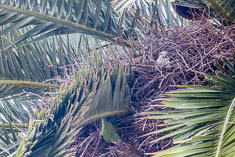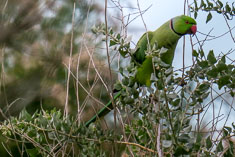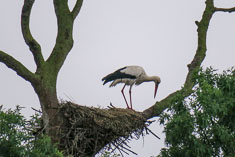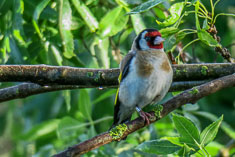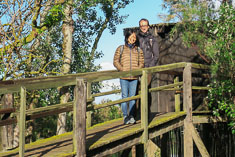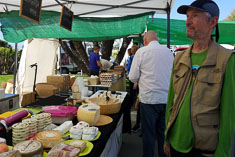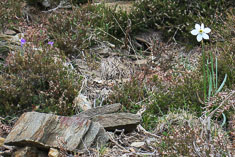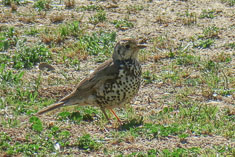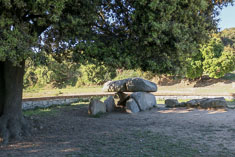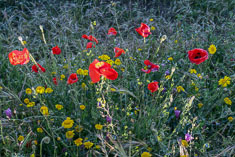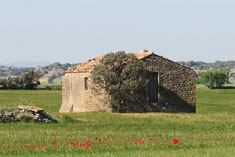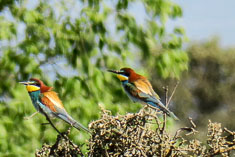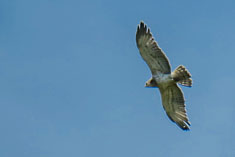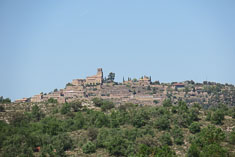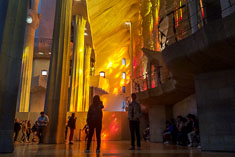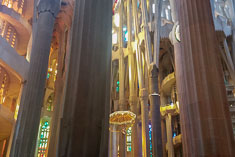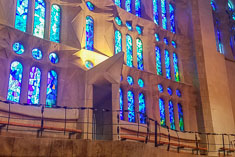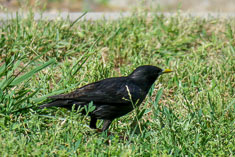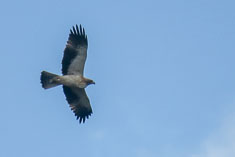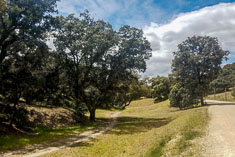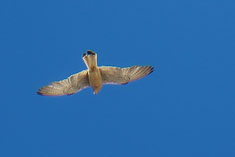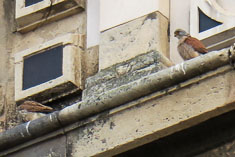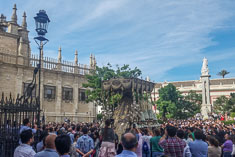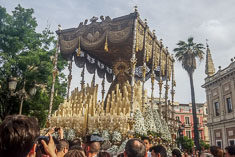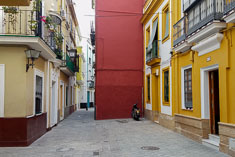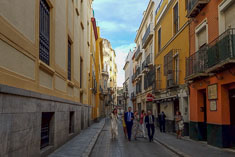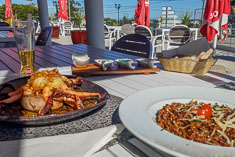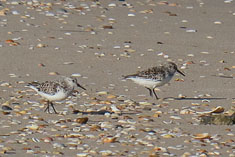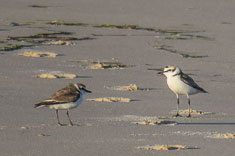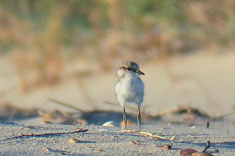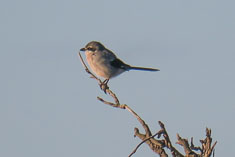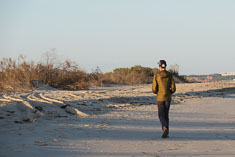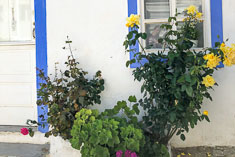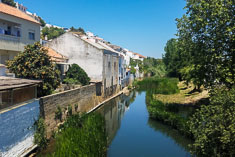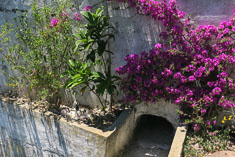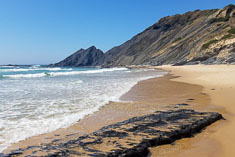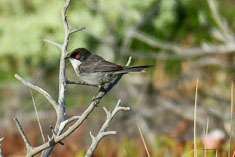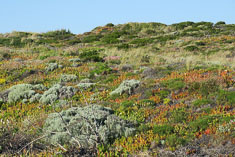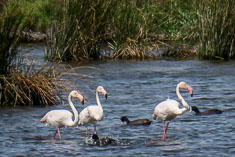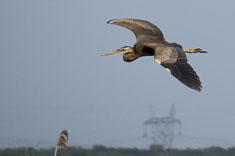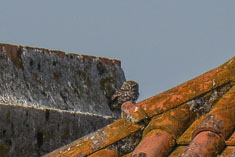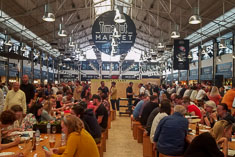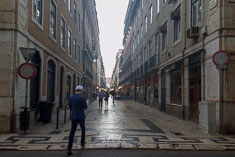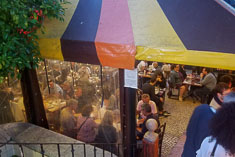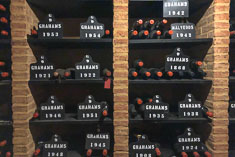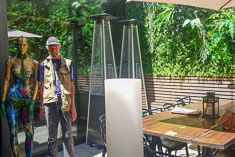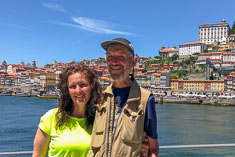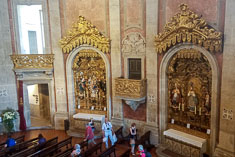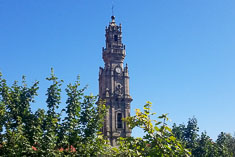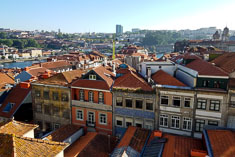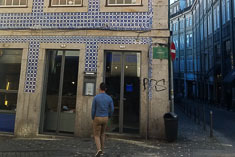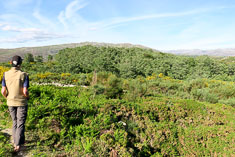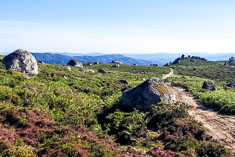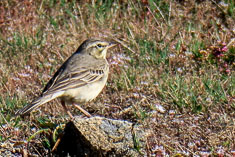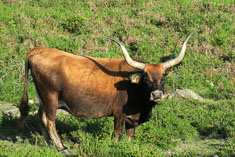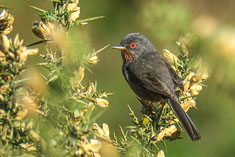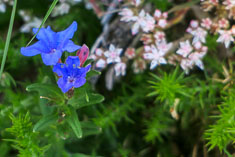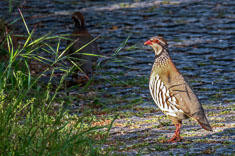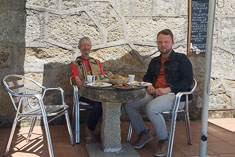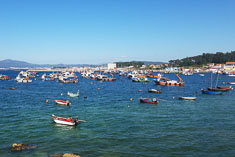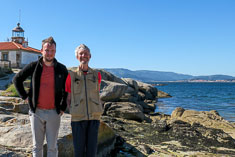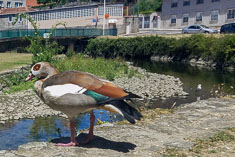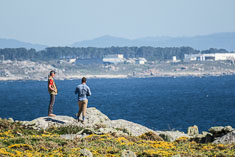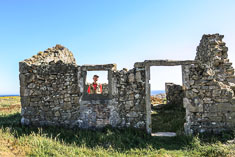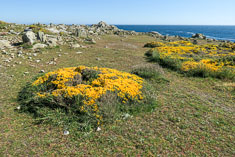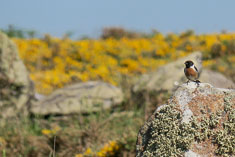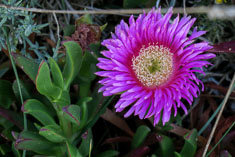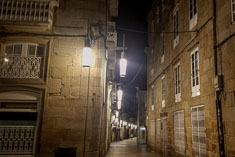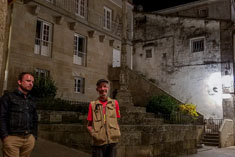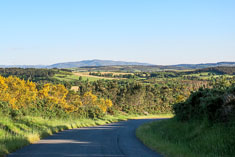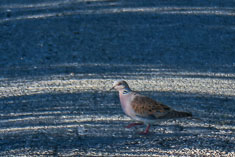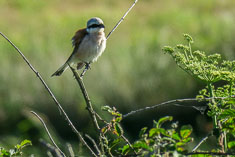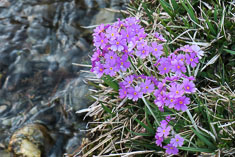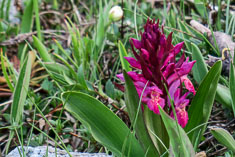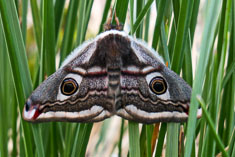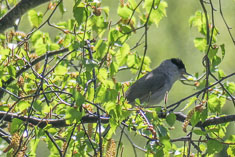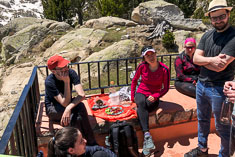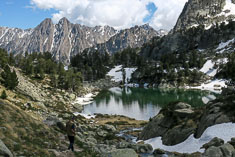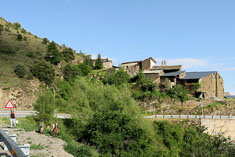05/09/2019 Spain and Portugal
Our plan was to spend five days visiting E and J in Barcelona then catch a train to Madrid for a couple of days and on to Sevilla for a couple of days. There we would rent a car For 10 days and drive along the coast of Portugal up to northwestern Spain where we would return the car at Santiago de Compostela and fly back to Barcelona, spending a couple more days there before flying home. Beyond soliciting advice from Daniel about what to do in Galicia and from a neighbor about what to see in Lisbon and Porto, we didn't do much planning before we left.
I didn't write about it after we got home either, nor did I do much with the 5000+ photos that Darchelle took during our trip, until about two months later. Now that the bloom is off my memories I am trying to write up an account of our travels. It won't be as fresh as it could be but at least we can look at the pictures.
Day 1: Arrive in Barcelona
J and E met us at the airport. They were actually waiting for us as we exited baggage claim but we missed each other and it took another half hour to connect so we didn't leave the airport until maybe 4PM. On the way home we made an impromptu stop at a wildlife refuge right near the airport after I mentioned having seen some big white birds below us as we were landing.
When we found a place to park at the municipal funeral home adjacent to the refuge, parrots (exotic!) were squawking overhead and House Sparrows (not so exotic) were chirping all around us. We did see additional interesting species on our walk and Darchelle got some photos, but I wasn't able to relocate the big white birds I had seen from the air.
J and E made the first few days of our trip so easy for us, we will always be grateful to them. They drove us out to their apartment in Premià de Mar, fixed us delicious meals, gave us their bedroom and devoted most of the next several days to showing us around the area. Not to mention being great company!
Day 2: Girona and Aiguamolls de l'Empordà Parc Naturel
Although we did not do much planning, J did a considerable amount of research and planning on our behalf for our visit to Catalonia. For the next few days of our visit, he and E took us to some of their favorite places as well as to some others that they thought we might enjoy.
The flower festival at Girona was our first destination. Thanks to our jet lag, we did not get an early start. Parking was a challenge at midday but J persisted and found us an excellent spot quite close to the old town where large and intricate arrangements of flowers adorned historic buildings. After augmenting the crowds for a half hour or so we retreated to the city wall, ate lunch in a little park and wound our way back into town for dessert and coffee once the crowds had thinned out a bit.
The flowers were glorious but my highlight was actually a Blue Rock Thrush which Darchelle photographed on the tower of a building near the wall. When I asked her to take its picture I thought it was a Spotless Starling, then was delighted to be wrong about the ID because I have been looking for a Blue Rock Thrush ever since my first visit to Spain back in 2010.
A rainstorm was just clearing as we arrived at Aiguamolls. We walked down a tree-lined gravel lane serenaded by Nightingales hidden in the dripping foliage. White storks guarded huge stick nests in isolated oaks and herons foraged in damp pastures. At the end of the trail we climbed an observation tower and looked out over flooded fields full of stilts and ducks. A slender falcon dashed overhead and I called it a Hobby, my first one for Spain. We ended up with a pretty good bird list despite running out of time to walk out to the beach.
Day 3: Monseny - Turó de l'Home hike
Yesterday we visited the coast but didn't have time to see some of the cute villages right on the water. We considered doing that today but decided instead to take a hike in the mountains northwest of Barcelona. Monseny was one of the locations recommended by a bird guide I had contacted online so I was excited to explore it. On the way out of town we stopped at a farmers market and a bakery to pick up some lunch. J is quite discriminating when it comes to bakeries but I think this was one of his favorites and E had a friend with a stand at the market.
The trailhead is in the montane beech forest at around 1200m elevation. On the way up there we drove through chaparral and pine-oak woodlands in the lower foothills then a mixed oak forest where we saw our first cork oaks, their trunks stripped of the rough outer bark (the cork) and painted a rusty orange color. I would love to have spent a morning in the oak forest but there wasn't time.
There were birds in the beech forest though, despite the lack of understory there, and up in the chaparral above tree line as well, along with a few flowers. I was particularly intrigued to see drifts of Pheasant Eye daffodils up there, huge patches of the fragrant blossoms. The ridge tops were in and out of the clouds but we had good views nonetheless. We hiked about 4 miles altogether with about 1600 feet elevation; I found it quite strenuous both up and down.
Day 4: Alella
Alella, a town nestled in the foothills a few kilometers southwest of Premià de Mar, is where the climbing starts for J when he goes out for a ride on his bike. He took us there today to show us some of his favorite routes, beginning with lunch at Restaurant Can Duran, aka Café de Baix. The food was delicious. I had codfish in a tomato-based sauce (Bacallà amb Samfaina, I think), which J informed me is a traditional Catalonian dish.
We drove winding roads up steep hillsides forested with evergreen oaks overlooking the Mediterranean. Up on top we walked a mile or so on a quiet gravel road past woods and pastures to an ancient church. A European Jay perched really close to me behind the church but Darchelle was not with me so I did not get a photo, but I did a checklist. We stopped again to photograph flowers and admire an ancient stone structure, maybe an altar. A herd of sheep, escorted by a shepherd and his dogs, enveloped us then moved on.
Back in town we visited a bar known for their pickles and canned seafood. At least that's what we ate, and I had a local beer. After our supper we stopped by a supermarket near the Premià de Mar Marina. E bought a bottle of fresh squeezed orange juice, filling it herself from the orange juice machine. It was amazing. At the marina at sunset I spotted an Audouin's Gull, a bird I very much wanted to see. It was a good day.
Day 5: Lleida Steppes
Darchelle and I hired a bird guide and the spent the day with him in the dryland farming country northeast of the town of Tàrrega, which is a little over an hour's drive northwest of Barcelona and about 20 miles east of the city of Lleida. Wheat appears to be the primary crop, grown in fields large and small separated by strips of oak and maquis vegetation. Our guide, Carles Oliver from Barcelona Birding Point, knew the birds and natural history really well and knew English well enough. He took us to half a dozen different locations where we found a total of about 60 species, many of which I would neither have found nor identified without his help.
Here is a list of our bird lists for the day:
Day 6: Barcelona - Park Guel and Sagrada Familia
Darchelle and I visited Gaudi's famous Park Guel (pronounced Parkway) first thing in the morning. It was already crowded with mostly Asian (it seemed) tourists vying for selfies with views. We did likewise. Gaudi's intention was to create decorative architecture which reflected nature. It did not look very natural to me but I enjoyed the color and the fanciful shapes. A bit gaudy at in places. After touring the central part of the park, to which access is restricted to limit crowding, we hiked the trails up the wooded hillside which forms the backdrop for Gaudi's buildings. We heard lots of Sardinian Warblers and Serins in the oaks but were not able to get any photos.
We met J and E for lunch at Rasoterra, a vegetarian restaurant in downtown Barcelona. The food was excellent; the croquettes in particular were the best we had anywhere on our trip. After lunch J led us on a brief tour of the old town before he had to go back to work, then we made our way to the Sagrada Familia.
From the outside I thought the Sagrada Familia, Gaudi's almost-completed Cathedral, looked too busy and cluttered for a major architectural work, with its 12 towers and hundreds of exterior stone bas-relief sculptures illustrating stories of the Christian faith. From the inside though, late in the afternoon on a sunny day, the church makes a very different impression. The soaring pillars and vast open interior suffused with brilliant orange and blue light convey an experience of transcendence and beauty.
We began our tour of the interior with an ascent (via elevator) and descent (via spiral stone stairs) of one of the towers. I forget how tall it was but we were way up there. Unable to use the hand rail, I found descending the tight spiral stairway with its apparently bottomless open center to be quite intimidating. Once safely down again we wandered around the interior transfixed by the glorious colors of the sunlight filtering through the hundreds of stained-glass windows high overhead. With the exception of a couple of Asian women who shoved me out of their way in their haste to get somewhere else, the crowd of tourists sharing the sanctuary with us were equally in awe of their surroundings.
Day 7: Barcelona -> Madrid
J and E drove us to the train station. I tried to identify birds from the train but we were moving too fast. I think I spotted a few kites and egrets as we passed through various types of farmland, and maybe a magpie or two in an extensive area of oak savanna. In Madrid our AirB&B was an airy corner apartment above a café called La Esquinita Plaza Mayor, not far from the Plaza along Puerta del Sol. It was only about a mile from the train station but for simplicity we took a cab.
After a siesta we set out for El Retiro Park and the museum district. The famous museums were closed so we peered into a church where a service was in session then continued into the park. I admired the magpies and Spotless Starlings foraging in somewhat scruffy patches of lawn framed by neatly trimmed hedges. When we reached the Estanque Grande del Retiro I was tired so I sat on the wall by the water while Darchelle bought churros con chocolate from a nearby stand. They weren't very good but we ate them anyway while we waited for a small group of street dancers to fire up their break-dancing show but when they weren't able to lure an audience they packed up and we moved on.
Returning to our neighborhood we wandered through the Mercado de San Miguel in search of a late dinner but were overwhelmed by the variety of choices and there wasn't really any place for me to sit so we left there and found a sidewalk café nearby, a Basque restaurant named El Pimiento Verde. I don't remember what we ate but it was good, and it was nice to sit down. We shut the place down shortly before midnight but they didn't seem to mind waiting for us.
Day 8: Madrid
Studying the map on my phone I discovered a large natural area across the river about a mile away so I thought we could walk over there in the morning for some birding, get lunch somewhere in the nearby Latina neighborhood then hit one of the museums in the afternoon. It didn't work out quite as I had hoped but aside from a sketchy stretch in the midafternoon when getting lost in the wrong Latina neighborhood cost us much of our museum time, our day in Madrid turned out well. Breakfast at a local bar was delicious. Darchelle had a large piece of their Tortilla. I had the typical Spanish bread with tomato sauce but enhanced with lots of delicious Jamon Iberico. Unfortunately we didn't finish "breakfast" until almost 1PM.
The natural area near Casa de Campo consisted of oak savanna in what appeared to be remarkably good condition. We saw Black Kites and Booted Eagles and other interesting birds but I left feeling that we missed as many species as we found. Breakfast was wearing thin by the time we wandered into the Latina neighborhood, a residential area of high-rises from which I had difficulty finding a way out. I couldn't figure out the buses or how to catch a cab so Darchelle found a subway station and got us back to the big train station at Atocha.
We decided to visit the Thyssen-Bornemisza Museum and were surprised to discover not only early
European painting but also a nice variety of American works from the 19th and 20th centuries, though
we ran out of time for the newer pieces. We had about an hour and a half; we needed twice that.
Darchelle took photos and nobody seemed to mind. The paintings pictured above are by (from left to
right) François Clouet, Martin Johnson Heade and Alfred Thompson Bricher. Clouet lived in France
in the 16th century and apparently titled this painting "The Love Letter". Heade was an American
painter loosely associated with the Hudson River School who is known for his orchid and hummingbird
paintings, among others. Bricher was a contemporary of Heade's who did a lot of painting in New
England, particularly along the coast but also in the White Mountains.
At closing the Thyssen-Bornemisza evicted us so we retreated to the cafeteria for coffee and pastries then wandered back to our own neighborhood and began the search for dinner. By 9:00PM it was getting dark and there were lots of people in the streets, most of them walking around but a few sitting at tables outside the many cafés. As we were walking down the street below Plaza Mayor a man outside the Taberna Tita Pepa urged us to come in so we did. The decor was rustic - wood beams, barrels, rough slabs on one wall - and the place was crowded, almost standing room only. A couple of men were playing guitar and singing in one corner and a few people were singing along. Nobody was eating much so I ordered only a glass of wine, and didn't finish it.
I don't remember why we chose Bar Eduardo. Maybe because it was brightly lit and full of people, and we were tired of looking at places and not trying them out. At any rate, it was a memorable selection. It was the first time we tried Pimientos de Padron and they were so good we ordered a second plate. It was also the first time I ordered vermouth, a regional specialty, and I loved it. Unfortunately I left my favorite straw in my vermouth glass.
Day 9: Madrid -> Sevilla
On Daniel's recommendation we stopped at La Mallorquina at the edge of Puerta del Sol and bought a Napolitana de chocolate. Basically an oversized chocolate croissant. The train to Sevilla was another fast one with a brief stop in Córdoba. I've been there.
We caught a cab to our hotel in Sevilla, the Hotel Casa 1800 Seville. Darchelle had wrestled with the question of whether or not to book it because it was expensive (~€500 for two nights) and she was afraid I would veto her choice. Had she told me I might have, but having stayed there I certainly don't regret it. The location was right by the Cathedral in the old part of the city. We had our own private rooftop patio with our own hot tub. The bathrobes were luxurious and the continental breakfast delicious. The two nights we spent there were the best of our entire trip. Even my ventilator worked perfectly.
I had selected Seville as a stopover on our trip for basically one reason - Lesser Kestrels nest in the nooks and crannies of the Cathedral and in my previous visits to Spain, I had never seen one. As soon as we checked into our room, we climbed the stairs to our private rooftop and almost immediately a Lesser Kestrel flew right overhead. It was a sign.
When we ventured out of our room the square around the Cathedral was packed with people. Some sort of religious procession featuring a large and ornately gilded float was slowly circumnavigating the church and hundreds of people were crowded around it. Although the blonde Virgin Mary housed in the float looked worried she conducted herself with utmost propriety, but the float itself swayed and occasionally shimmied in an oddly seductive way.
Away from the Cathedral the narrow streets and passageways of the Jewish quarter were quiet. We wandered through, emerged on the far side and used our phones to find our way back again. It was early for dinner but we were hungry so we sat down at a table along the alley just up from our hotel. The table apparently belonged to Taberna Belmonte, one of a row of restaurants lining one of the access streets for the Cathedral. It was the sort of place that I would normally assume was primarily for tourists and therefore would not patronize, but sitting outside the back door of the place, it didn't feel touristy at all. A server appeared shortly and told us we were welcome to order food so we did - Grilled Artichokes, Salmorejo (Andulsian version of gazpacho), Stuffed Eggplant, Zucchini Croquettes and Oxtail Stew. Everything was delicious and the bill was under €20. So much for avoiding the touristy spots.
The evening was yet young so we wandered some more. Perhaps because it was Saturday night all the cafés and bars were crowded but even the streets were busy, and not just young people or tourists out for the nightlife but Spanish-speaking families with children and older couples as well. We ended up at one of the cafés facing the Cathedral because they had lava cake on the menu. Our server was from Poland but spoke both English and Spanish quite well. He had come to Spain five years ago, I think he told us, and and studied Spanish for less than a year before getting a job as a server. He said English took him about a year of study as well.
Day 10: Sevilla
The best thing about the breakfast bar downstairs is that it stayed open all day, but it was also well-stocked with various croissants and pastries, glasses of yogurt and tomato salsa, cheeses and thin-sliced Jamon de Iberico and other meats, and of course fresh fruits and juices. We sat in the central courtyard and enjoyed a feast.
Around noon we set out to explore the city. We gravitated towards parks, first the rectilinear Prado de San Sebastián where Darchelle sat on a bench and booked reservations for the Alcázar on her phone while I looked for birds, then the imposing Plaza de España where we watched part of a flamenco dance performance. Venturing into the gardens of Parque de María Luisa we found a pleasant bench by a pool. A young woman sitting on an adjacent bench asked us where we were from and we got to talking for a while. She was from Canada. A boy maybe six years old came along and started trying to catch little fish with a plastic bag skewered on the end of a stick. Soon his older sister started watching him, then his father came along with two more boys, all in blue shirts. Nobody showed much interest in fishing until suddenly the younger brother caught one, then everyone wanted in on the action.
We returned to the hotel for coffee and a snack from the breakfast bar then walked over to the Alcázar and got in line, which was now much shorter than before since the palace would be closing soon. They let me in free because I was disabled. We walked through exterior courtyards and interior rooms, the latter decorated with elaborate tile work which appeared to be of Moorish origin but was actually commissioned by the Catholic king after the Christians took the city back from the Moors. Ditto for the rest of the palace and gardens, which seemed to have a complicated history mostly postdating the Reconquista. At closing guards came out into the garden and herded us dawdlers unceremoniously out the gate. That was okay; even our limited time in there was worth the price of admission.
We watched the sunset on the belltower of the Cathedral from an outdoor café along the edge of the square. I sipped vermouth and ate green olives (a combination recommended in a guide book) while Darchelle purchased gifts for the folks back home at a nearby spice shop. We turned in around 10, early by local standards.
Day 11: Sevilla -> Quinta das Alagoas
Once we located the rental car office at the Seville train station, we picked up our rental car and started the second stage of our trip - driving the length of Portugal. First stop was Punta Umbría near Huelva. I wanted to go to the nearby natural area, the estuary of the Odiel River, but I couldn't find an access point. Instead we parked in a sandy pullout along a band of scrubby pines where a paved trail appeared to head out towards the beach. Darchelle was sleepy so after she got me ready to go she settled into the car for a nap and I set out for the beach. I didn't get far. Stepping up onto the trail I tripped and fell on my face on the pavement. Other than a scrape or two I wasn't hurt but I could neither get up nor get Darchelle's attention even though I was only 10 feet from the car. After a few minutes another car pulled up and the people in it rushed to help me. I managed to tell them to get Darchelle. She was fully awake by the time she finished rescuing me so we walked out to the beach together.
I noted a few birds but we didn't stay long. New species included my first confirmed Pallid Swifts overhead and a small group of Iberian Magpies in the pines.
The south coast of Portugal is called the Algarve and we drove most of the way across it before stopping for lunch at an open-air café called O Rústico Restaurante. I ordered grilled octopus and they brought me the whole thing. It was delicious, sweeter than other octopi I've had, but unfortunately I could only finish half of it. Reading a guidebook during lunch we discovered that we were only a few miles from one of the most beautiful beaches in the world so we drove down there. I might not have rated it that highly but it was colorful - clear blue and green water, orange sand, yellow cliffs, dark shadows and bright sunlight, blue sky overhead. The air was a bit cool so we weren't particularly tempted to try swimming. Not that I could swim anyhow.
Darchelle had found an interesting AirB&B for us outside of Lagos in the southwest corner of Portugal, a room in a fortified farmhouse from the 14th century named Quinta das Alagoas. A notebook in our room provided information about the history of the building. The thick walls provided protection against pirates while the interior courtyard offered a safe location for drying the fig crop, figs being one of the primary products of the farm as recently as a generation ago.
As the sun drew near the horizon we decided to watch the sunset over the Atlantic from Cabo de São Vicente, the southwesternmost point of Europe. We arrived just after the sun dropped behind a thin line of clouds on the distant horizon. Once again we missed the green flash. Other than that offending line of clouds the sky was clear and a brisk wind was blowing from the north so the crowd of people who'd had the same idea we had dispersed quickly, abandoning the impressive headlands to the gulls, swifts and Sardinian Warblers who have possessed them for millennia.
Day 12: Lagos -> Vila Nova de Cacela
We drove into the coastal town of Lagos for breakfast, or rather lunch, then drove a few miles out to the colorful and convoluted, and rather crowded, headlands of Ponta da Piedade.
We searched for access to the little pocket beaches at the foot of the cliffs but couldn't find a way down. I was still feeling unsure of my footing as a consequence of my fall yesterday and Darchelle and I weren't sure, or perhaps weren't in agreement, as to just what we were looking for. The scenery was very nice, the flowers colorful and the birding respectable for the heat of the day but we probably spent too much time there.
Darchelle, looking online while we had coffee and a snack out at the point, discovered a beach described on Lonely Planet as "lonely and lovely" and "Best for: skinny-dippers, philosophers, romantics". The article mentioned that this special beach could be accessed by walking to the end of the beach at Manta Rota, so Manta Rota Beach, 80 miles back toward Spain, became our next destination.
We arrived shortly before 5 PM and checked in at the tourist office adjacent to the beach parking lot to ask about a place to stay. The woman at the desk said no problem, she'd call a friend of hers and told us it would take a few minutes for her to walk down and meet us. The tourist office then closed for the day while we waited in the empty parking lot. An older woman in a pink T-shirt showed up a few minutes later and she was our person. We drove her home and she showed us a spare but clean two-bedroom apartment which she said we could have for €25. Yes, we told her, then drove back down to the beach.
After a quick snack at a shack along the boardwalk (the very first time we tasted the ubiquitous Portuguese custard tarts called "pastéis de nata"), we set out down the beach. As advertised, it was lonely - we passed only one or two people in over a mile - but a cool breeze was blowing off the water and we were not even slightly tempted to skinny-dip, or to get romantic for that matter. I was pretty distracted by the birds anyhow. There were new ones, including nesting Little Terns and Kentish Plovers, and Darchelle got into trying to photograph them, along with some of the flowers.
Manta Rota Beach ended in a sand spit where a wide shallow channel connected the ocean on our left with a quiet estuary on our right. The beach continued on the far side of the channel but it was getting late so we didn't attempt to cross. Little Terns attended a few nests on the spit while on the estuary side Kentish Plovers skittered ahead of us on the damp sand. Back at the car park the light was too low to identify small birds in the treetops by the restrooms.
On the way back to our apartment we found a corner restaurant named A Proa. The decor was nautical, the crowd sparse, the food delicious as usual. I had a tuna steak, very good but too large. After dinner and on a whim, we made a brief detour to a farm road just outside of town and played a recording of a Little Owl. Not one but two Little Owls hooted back at us from across the bare fields.
Day 13: Cacela Velha -> Sines
If I ever return to Portugal, it will be in no small part because of my memories of this day spent exploring the Alentejo - the beaches and headlands, the flowers, the food, the villages, the history, the people. We even added a few birds to my Portugal list (51 species so far).
In the morning before we left, Manuela (I think that was her name) loaded us up with plastic bags of fruit, but first we toured her garden, a patch of green surrounded by bright white suburban villas. Fruit trees - citrus, peaches, pomegranates, figs and others - were scattered around garden beds for tomatoes, beans, New Zealand spinach, onions, melons and more. A ramshackle chicken coop anchored one end of the plot. The soil was the same rich orange color as the wet sand on the beach.
Before the Algarve was a tourist destination it was primarily agricultural. New towns have been built up on top of the old fields and orchards but remnants remain. Manuela's garden is one. A handful of ancient olive trees scattered over the interior of a roundabout were another reminder of former times.
There are apparently two Vila de Cacela's, the new one where we stayed last night, and the old one with the castle built on a bluff overlooking the estuary and beaches. We visited the old village, Cacela Velha, this morning on our way out of town. The castle was closed but we had coffee and pastries in a little café then walked down to the shore of the estuary below the castle. We also figured out something we hadn't realized yesterday evening, that the lonely and romantic beach which we had intended to visit, Praia de Cacela Velha, had been the one on the far side of the channel. Now it stretched out below us and out of sight to the west from our vantage point on top of the walls of the old town.
Our next stop was the Castle of Aljezur, a Moorish and Christian fortress guarding the once-navigable Aljezur River. The old town below the castle was apparently a port prior to the great earthquake of 1755, which not only destroyed the castle and town but also rendered the river impassable. It was hard to imagine that the river, now a languid stream a few inches deep, once hosted cargo vessels. Minnows frequented the shallow pools, attracting a flashy Kingfisher which in turn attracted me, though I could not relocate it for a photo.
We ate lunch at the popular Pont'a Pé restaurant along the stream where the Old Port used to be. We shared vegetable soup then I ordered the fish special and Darchelle the vegetarian omelette. As I recall, our server spoke Spanish to us which was unusual since few people we met in Portugal spoke Spanish. I think he called the soup "Sopa de verduras" and my fish "Pescado perro", which I translated in my mind to Dogfish, a type of small shark. Years ago when I was kayaking in the islands off British Columbia, we caught a dogfish when we were fishing for rockfish, but we did not eat it. Served in a tomato pepper sauce with sweet potatoes, it was delicious, somewhat more rich than most whitefish. The sweet potato pudding on the other hand was dense and sweet but not particularly interesting.
After lunch we drove a few kilometers west to the beach at the mouth of the Aljezur River, Praia da Amoreira. The beach consists of a fairly short stretch of orange sand below precipitous bluffs and a longer section of dunes along the lower mile or so of the river. The part of the beach facing the ocean is popular with surfers; the river section is more for families with children. Seeking privacy we walked upstream along the river but by the time we put sufficient distance between us and the last party we passed, two topless women with several small children, the water had become quite shallow. We stripped and waded in but couldn't really swim. I found the motion of the wind ripples on the surface disorienting so I had Darchelle help me dip to rinse off the sand then returned to shore to warm up. On the way back to the car Darchelle played in the surf for a few minutes while I watched somewhat anxiously (and enviously) from shore. She loved it.
Although the sun was getting low I wanted to at least briefly explore the coastal headlands so we started up the Rota Vicentina, a gravel track up a gradual hillside carpeted with colorful coastal scrub. Stonechats and Sardinian Warblers were common and before the camera battery died Darchelle was able to get our first good photos of those species. Flowers were common as well, though probably past their prime. I was sad to see Ice Plant, the invasive succulent from South Africa, displacing the native vegetation and degrading the habitat for all other inhabitants of the ecosystem.
Without any plan for where we would spend the night, we headed north around 8PM. We kept an eye out for places to eat but passed only a few unpromising road houses before pulling into Sines (pronounced Seenesh) around dusk. Somewhere near the center of that small port city we found an open café which turned out to be associated with the Origens Hostel, which turned out to have a double-bed room available for a very reasonable price. They did not have dinner though so after checking in we wandered around the old town until we found an open restaurant. Though Nau was bathed in cold florescent light and patronized only by a handful of older men, we went in anyway. I ordered Octopus salad and grilled fish. The fish was whole and bony but reasonably tasty; the salad was amazing.
Day 14: Sines -> Lisbon
In the morning we strolled around town a bit and stopped for coffee and pastries at a café called Vela d'Ouro. Though we ate them wherever we went, Pastéis de nata were nonetheless somewhat uninspiring for breakfast. Espresso on the other hand was consistently delicious throughout Portugal.
On the way into Lisbon on the E90 we stopped at a gas station and rest area called Galp Palmela Norte where we picked up some fast food for an early lunch, and with considerable effort managed to obtain the key to the restrooms. Subsequently, and enticed by an unfamiliar song (which turned out to be a Black Redstart), I also found some other birds in the pine grove behind the bathroom building. One more bird note - on our way into the city we passed a Stork rookery on a power line tower on which we counted 17 nests; according to the bird guide we talked with later, the record is 19.
Darchelle had booked an AirB&B in the Ajuda district but we thought we'd stop by the waterfront on the way there. Bad move! The area was crowded with people and cars and we could neither move nor park. Eventually we found our way out of there and to our apartment. After lunch at a rather nice restaurant named Recanto Serrano which featured regional (non-vegetarian) specialties, we drove out to Sintra, a forested park and garden quite unlike anything we had seen so far in Portugal.
The park encompasses a number of different sites, some more historic than others, across a range of forested hills which apparently rake the moisture out of low-lying clouds blowing in off the Atlantic. The forest feels lush and damp. Both trees and understory appeared to be a mix of native and introduced or planted species. Into which category the abundant English ivy fits, I don't know. The pink-flowered rhododendrons were introduced in the 19th century when the park was built; they were apparently all the rage among gardeners back then. Nestled among the trees are sturdy structures of stone and stucco, little chapels and monuments, cobblestone patios and stone bridges. We followed cobblestone paths through flower gardens and wooded groves, gradually trending upward until we found ourselves tracking up a steep stone road to a fog-swept hilltop surmounted by a concrete cross, "Cruz alta". It had some history attached to it but I don't recall what it was. I was too cold to pay much attention.
Retreating from the cross we worked our way over to another attraction, the Romanticist Palace of Pena constructed by King D. Fernando II in the mid-19th century, in part from a pre-existing 16th century convent. The palace was closed for the day. We had not bought tickets for it anyhow, having arrived rather late in the afternoon. We also had not done any research ahead of time. If we had, we might have chosen to visit the Moorish Castle instead of the Cross. It would have been a comparable hike.
Cabo da Roca, the westernmost point of Europe, is just a short drive west of Sintra so we drove out there to catch the sunset. There were clouds, and a cold breeze, so we watched from the warmth of our rental car. If I were to visit again, I would want to look for some of the traces of the 1755 tsunami as reported by this 2005 study.
Day 15: Lisbon
After coffee somewhere I'm sure, though I don't recall where, we walked down to the waterfront where we visited neither the Carriage Museum (no line), the Jerónimos Monastery (long line) nor the Pastéis de Belém bakery, the self-proclaimed source of Pastéis de Belém which may be the original incarnation of the national pastry, the Pastéis de Nada. Instead we ascended the tower of the Padrão dos Descobrimentos monument, which commemorates the age of Portuguese exploration and dominance. From the top, we could see our neighborhood.
We walked along the waterfront and away from the crowd into a neighborhood called Restelo where, about a block beyond a tire store, we found a restaurant called Tasca do Gordo. I had read in guidebooks that when in Portugal one must try the grilled fresh sardines. Tasca do Gordo was the first place we found that had them. They came whole. When the woman seated at the table next to us saw Darchelle trying to fillet the sardines in accordance with my instructions she took pity on us and offered to help. She took my plate and neatly boned the fish, placing the meat (but not the skin) on my salad plate and sprinkling it with olive oil and salt. "The skin is bad for you", she explained, mostly in Portuguese. When she wasn't looking her husband, across the table from her, whispered to me in rather good English, "It's the best part!", but in deference to her I didn't get to eat much of it.
Our birding guide met us at the restaurant. Some months ago Darchelle had heard a program on Rick Steves featuring a birding trip out of Lisbon with a guide from a company called Birds & Nature Tours Portugal. Once we figured out what dates we would be in Lisbon (about five days ago) Darchelle emailed them and lined up a private guide for a half day tour of the Tagus Estuary Nature Reserve. We would have preferred a full day but they did not have anyone available. Bernardo Barreto was our guide and he knew his stuff. He assured us that we could probably find 60 species even though we were only going to be out for four hours. We got 70, and almost half of them were new for Portugal.
Bernardo took us to five different locations east across the bay from downtown Lisbon, including as he described it in an email, "a private farm near the reserve with two great habitats: Cork Oak forest and old salt pans". Using his scope we also scanned pastures, fields and marshes, freshwater ponds and channels and a mudflat. The Cork Oak forest was more like a few dozen trees in a weedy field, but it offered us a chance to see Cork Oaks up close and learn a little about how the cork is harvested. Every nine years they cut and peel a slab of bark about 2cm thick from the trunk and larger limbs of the tree. They mark the year on the trunk so they know when to harvest it again. Some of the older trees had been harvested at least half a dozen times.
Here is a list of our bird lists for the afternoon:
It was not a good evening. Bernardo dropped us off near the big indoor food court called "Time Out Market" but it was hard to choose what to eat and even harder to find a place to sit. I think we bought a couple of pastries. Darchelle had read about a restaurant up on the hill so we hiked up there, traversing the section of downtown Lisbon which the influential Prime Minister Marquis of Pombal rebuilt after the 1755 earthquake to be resistant to future earthquakes. When we reached the restaurant, Chapitô à Mesa, I thought it looked too touristy and didn't want to wait half an hour in line for a table. Darchelle was angry that I was not willing to let her choose a restaurant but when I relented she said I had spoiled the experience for her and no longer wanted to eat there. I felt that I had really fucked up, and I had. It would have been excellent meal and a delightful conclusion to a very nice day. Instead we stalked off down the hill and eventually caught a taxi back to our apartment. If we ended up eating somewhere else, I do not recall it.
Day 16: Porto
Sometime before we left for Portugal Daniel had arranged for us to attend a free Port tasting at one of the top Port houses in the port of Porto. A fancy lunch was apparently part of the deal so we needed to be there right at noon on Saturday, today. When I realized that it would be nice to have an extra day in southern Portugal, I tried to contact Daniel to change our appointment but he never got back to me. When we arrived at Graham's I discovered why. Daniel was sitting in the lobby of the restaurant waiting for us.
I was of course startled to see him, and delighted too. He was going to be in Portugal for about five days and would give us a personal tour not only of Porto, but also of the areas in northwestern Spain where he as lived several years ago. We would visit wineries and some of his favorite restaurants as well as scenic spots along the coast. Only one problem that I could foresee - this was Darchelle's and my trip, and I didn't want to welcome Daniel to join us and plan our itinerary without first talking to Darchelle about it. As we were sitting at lunch I was trying to figure out how to bring this up with Daniel but Darchelle beat me to it. She started talking about how difficult it had been to coordinate meeting up with Daniel without me finding out about it. She had totally succeeded.
Lunch at Vinum was elegant. Our table overlooked the Douro River with Porto (for which Port is named) on the left and Vila Nova de Gaia (where Port is actually aged) on the right. Daniel had Octopus, I had fish and Darchelle had a vegetarian entrée. For dessert we had grilled pineapple and something with chocolate. We did not have Port; that came later, after our tour of Graham's cellar - their Port storage and ageing facility. During the tour we learned about the different types of Port - Ruby, Tawny, Vintage, etc - and about the vineyards upstream along the Douro River where the various grapes fermented into Port are grown. The Douro River, thanks to the efforts of the previously mentioned Marquis of Pombal, was declared in 1756 only the third official winegrowing region in Europe. Until fairly recently, only wines which were aged in Vila Nova de Gaia could be officially called Port; maybe that is even still the case.
Graham's offers two levels of Port tastings. We got the fancy one, which included four different types of Graham's Port with three different ages of the Tawny. They all tasted good.
Darchelle had booked us an AirB&B with two little houses separated by a courtyard surrounded by flowers, located just a block from Graham's and about a 10 minute walk from the waterfront in Vila Nova de Gaia. After our Port tasting we retired there for late afternoon naps. When we got going again sometime around 10PM we walked around the corner to a local restaurant named Perto do Cais which specializes in a gut-busting local delicacy called Francesinha, roughly translated as "Frenchy". The place was packed when we arrived so we had to wait about 20 minutes for a table. Newer arrivals were seated before we were so apparently they took reservations. The clientele was a mix of all ages from high school on up. The main attraction was a hearty ham or steak sandwich smothered in yellow cheese, baked in a woodfired oven and served with a fried egg on top. Most adults ordered beer with it. We did too.
Day 17: Porto
Despite the one drawback of otherwise idyllic AirB&B, two large and nervous dogs which barked in panic whenever they noticed our presence, we managed to sleep in until lunchtime. We ate at a cosmopolitan coffee shop called 7groaster just off the waterfront in Vila Nova de Gaia - really excellent coffee and very good food - then walked across the bridge to Porto. The waterfront was quite crowded but as we followed winding cobblestone streets up the hill the crowds thinned out.
While up on the hill we visited a bookstore, Livraria Lello and a church, Igreja dos Clérigos. We had to buy tickets and wait in line to get into both of them, and both were nonetheless quite crowded. In the bookstore the main attraction is not the books but the stairway to the second floor. We and others waited to get pictures of ourselves during moments when the staircase was not too crowded. The church was quite ornate inside but the main attraction there is a tall narrow belltower. An elevator took us part way up and a one-lane stone stairway with pullouts, the rest of the way. On the last full spiral, there was no room for people to pass one another so up and down traffic had to alternate. Nice view of the city from on top though.
One of the most appealing features of Porto of is the tilework. Many buildings in the older parts of the city are ornamented with ceramic tiles, and often in combinations which create intricate and colorful patterns.
For dinner we caught a taxi out to the coast to a rather nice restaurant called Cafeína. It was quiet and elegant and I assume the food was excellent though I do not recall it. Daniel enjoyed talking wine with the somelier and the server, a young woman whose English was excellent. We could not place her accent so we finally had to ask her. She made us guess but we didn't get it. South Africa.
Day 18: Porto -> Ponte da Barca
Having spent our entire visit to Portugal on the coast, we wanted to go inland to the mountains for our last day in the country. Looking back, it feels as though we spent all day driving and only managed to do just a short walk in the mountains. That wasn't quite how it went down. In reality, we got up late, walked down to 7groaster for coffee and breakfast, or rather lunch, walked back up to our AirB&B, talked with the owner a bit, packed up and left around 1:30 PM. We stopped for about a half hour outside of Campo do Gerês so Darchelle could take a nap and I could do a checklist. A pretty little stream ran under a stone bridge and into some leafy woods with lots of underbrush where my first Portuguese Song Thrush was singing.
Continuing on, we traversed some high scrubby country dotted with granite boulders, headed nowhere in particular but starting to think about supper. When it started to appear as though we would soon be descending out of the mountains again I suggested we stop so we did, at the junction of CM1149 and CM1348 a couple of miles south of Germil. I did another checklist and Darchelle got some excellent photos of my first Dartford Warbler and other local flora and fauna.
Germil was typical of the mountain villages we passed through, a little cluster of gray stone houses hugging thorny hillsides of broom and gorse. As soon as we passed it we wished we had stopped but we didn't turn around. Of course if we had, we probably would have missed the little covey of Red-legged Partridge which crossed the cobblestone roadway just ahead of us, just outside of town. We passed tantalizing hiking trails here and there as well as we descended into the valley towards supper, but there was not time to hike them then, and now there never will be either.
Supper ended up being at a modern-looking little restaurant called Casa de Tapas in the riverside town of Arcos De Valdevez. The food was delicious and the most expensive bottle of wine on their list was only €18 so Daniel bought it. Our server, who was probably the chef and perhaps also the owner, seemed quite surprised when Daniel offered him the half bottle that was left when we finished, but he accepted it.
The wagtail was in the park (Praia Fluvial de Ponte da Barca) next to our hotel (Hotel Fonte Velha) in the morning. It and seven others made it onto my last Portugal checklist.
Day 19: Pontevedra
Pontevedra was our destination today. Daniel lived there for a year a few years ago and wanted to show us around the area so Darchelle booked a couple of rooms for a couple of nights at a hotel in town. Daniel had made an appointment for a wine tasting this afternoon at 3PM which left us just enough time for a quick lunch in the sun at Restaurante Novo Yaser. Their croquettes were delicious.
The Granbazán winery outside Vilanova de Arousa, about 10 miles northwest of Pontevedra and only a few miles from the Atlantic coast, appears to have some real money behind it. The vines are well-established, maybe 40 years old, but the rest of the winery with its state-of-the-art equipment housed in a colorful faux French château looks brand-new. They specialize in the characteristic and popular grape of the region, Albariño, which is grown on tall, horizontally-trellised vines to maximize airflow past the grapes in this moist maritime region. No other major winegrowing region is as wet. We toured the winery with the young and very knowledgeable winemaker then tasted a selection of their white and "green" Albariño offerings. The wines were tart and a bit salty with notes of citrus and stone fruit, at least that's what it says online; all I basically remember is that they tasted pretty good.
Continuing out to the coast we visited Illa de Arousa and took photos of the colorful fishing boats in the harbor then strolled around the granite ledges of Punta Cabalo, where I did a checklist. The landscape was lush and green (although Eucalyptus has replaced much of the native pine woodland), the beaches sandy and white, and the whole area begged for further exploration but we did not have time.
Combarro is an odd little stone fishing village hugging a beach across the bay from Pontevedra. Pictured above, it is known for its grain storage boxes (hórreos) made of stone and elevated off the ground on stone legs, which apparently kept the foodstuffs safe from rodents. Combarro is also known for its stone crosses but we did not get any photos of those. We shared a couple plates of appetizers at a café by the main square at one end of the old village before driving back to Pontevedra and checking in at Hotel Dabarca. For dinner, we walked over to Vinoteca Bagos, Daniel's favorite restaurant when he lived here a few years ago. The food was good and Daniel knew one or two of the servers but the chairs were quite uncomfortable and Darchelle and I were quite tired, so it was a long evening.
Day 20: Pontevedra
We slept in, walked a few blocks to an outdoor café called El Cafetín on one side of a tree-lined promenade, got coffee and food. I scarcely recall it; I must have been still half asleep. Lunch was more memorable. We ate two local seafood specialties, Pulpo (Octopus) and Zamburiñas (Scallops) at A Bodega, a colorful little restaurant in the seaside town of Ribeira. The Pulpo was not as flavorful as that which I had in Portugal but the Zamburiñas, grilled on the half shell with a garlic olive oil dressing, were amazing. Darchelle reported that her tortilla was the best She had tasted anywhere in Spain.
From Ribeira it is a short hop of a few kilometers over to the lighthouse at Cabo Corrubedo, another wind-scoured point on the coast north of Pontevedra. Spiny thickets struggle to get over a meter tall amid outcrops and boulders of gritty granite. Crumbling stone paddocks and close-cropped grass dotted with cryptic flowers suggested an ecosystem dominated by sheep but I didn't see any droppings. Perhaps the sheep departed with the occupants of the stone house in which Darchelle photographed me. She also photographed a few of the birds for me, though we bypassed the main birding spot in the region, a dune and marsh complex just south of the point.
Instead we drove a few miles north to Castro de Baroña, the ruins of a fortified village perched on a stony peninsula and accessed by an inconspicuous lane next to a restaurant parking lot. As it approaches the shore, the trail follows two parallel ruts worn several inches into the bedrock which lead more or less to the site. I have not been able to find any explanation of the traces but it was easy to imagine that they were made by the iron-rimmed wheels of horse-drawn carts hauling goods to and from the settlement 2000 years ago. It was apparently built and occupied for a couple of hundred years by the Gallaecians, a people of Celtic origin who occupied the Western Iberian Peninsula by around 500 BC and who were in turn conquered by the Romans around the time Castro de Baroña was established in the first century BC. That the occupants took the trouble to construct a fortified village on a peninsula without access to fresh water indicates that it must have been an unstable time; perhaps quieter times during the Pax Romana had rendered it obsolete by the time it was abandoned.
We returned to Pontevedra in time for supper at Bagos again. The shrimp were delicious again. We bid the Bagosians goodbye around midnight and wandered the stone alleys off the old town on our way back to our hotel.
Day 21: Santiago de Compostela -> Lugar de Riocalvo
Today was supposed to be a travel day. We would drive to the Santiago de Compostela airport and turn in the rental car then catch a taxi into town for a couple of hours to see the Cathedral before returning to the airport, putting Daniel on a flight to the US and catching our own plane back to Barcelona, where J had planned an outing to the Pyrenees for our last weekend in Spain. It is the sort of day that makes me anxious because I always expect to screw up and miss a connection but it always goes fine. Except today it didn't.
Airport, taxi, Cathedral - all good. Our taxi driver even offered to return and pick us up when it
was time for us to head back to the airport. The Cathedral was unexpectedly moving, emotionally I
mean. Seeing the trail-worn pilgrims snapping selfies in the Plaza below the imposing façade of the
church reminded me of watching marathoners crossing the finish line. Inside, the Cathedral was crowded,
the old stones stained by the smoke of thousands of candles. We waited in line to look at some stone
boxes which contained holy bones, I think, then emerged into the shadows of a sunny street and ate
lunch
outside a crowded café. Orange juice, coffee and jamon were all delicious.
Back at the airport we said goodbye to Daniel. In the rush to catch the flight there was no time to to reminisce and reflect, but what a gift he gave us, and particularly gave me, in taking a week of his limited vacation on short notice to travel with us and share with us his knowledge of the geography, the food and the wine of his Galicia.
Turning to check into our flight we discovered we were not actually booked on our flight, and it was now full. We explored alternatives and decided that our only reasonable option would be to catch a flight to Barcelona tomorrow morning. So now we had another day to kill in Galicia.
There was one particular warbler, a Dartford Warbler, which I hadn't seen yet on our trip; in fact it would be a life bird. (Later, studying photos from a few days earlier (Day 18), I realized that we had seen one but that I had misidentified it at the time as a Subalpine Warbler.) Doing a little research, I found an eBird hotspot not too far away where one had been reported recently, and it was conveniently close to the Camino de Santiago which Darchelle wanted to check out. It took us a little while to find a rental car and we had to pay more than three times the daily rate of the car we had just turned in, but Darchelle urged that we do it anyway so we did. We also found a little inn nearby so we were all set.
Although we followed the GPS instructions to the hotspot called Brañas de Xestoso I didn't realize that we were looking for a unique type of hilltop marsh so we never quite found it but we did find some native forest on the way up there and up on top, an area of chaparral in which Dartford warblers were singing, though we never did manage to see one. We accumulated a pretty good bird list nonetheless.
Our inn, the Eco Hotel Nos, was attractive, quiet and comfortable. Our dinner was one of the best of our whole trip. I ordered a glass of a local red wine and the server brought me an entire bottle so I was afraid she misunderstood me but she only charged me for the glass despite giving me a refill. My Zamburiñas were even better than in Pontevedra and the wine was delicious too.
In the morning we found a spot where the Camino crossed the road near our inn. The marker was inconspicuous and the trail unclear. I don't know how the pilgrims manage to find their way.
Day 22: Santiago de Compostela -> La Peülla -> Espot
J and E picked us up at the airport and we drove about four hours northwest into the mountains. I don't remember much of the drive; maybe I slept. We reached our destination, a verdant pass carpeted with short grass and framed by craggy peaks, around 6PM. On Google maps, the area is identified as La Peülla, and the pass itself is known as the Port de la Bonaigua. In the winter it is a ski area; in the summer the lower parking lot is a trailhead accessing the Gerber Valley and several alpine lakes. J led us on a short hike up to the first small lake, marked on the map as Estanyola de Gerber, giving us a taste of the Pyrenees before dinner.
The trail traversed mostly open slopes with lots of flowers for the first half mile then entered patchy pine forest for another short half mile to the lake. Some of the trees were quite old; I counted over 200 rings on the sawed-off butt of a fallen snag. With stops for flowers, birds and selfies we took an hour or so to reach the lake. Too bad there wasn't time to go further.
The grass was short and so were the flowers but they made up in color and variety what they lacked in
stature. Some of them were familiar, others not so much. I recognized some of them - a small
yellow daffodil and a crocus, cultivars of which grow in our front yard at home - and not others,
such as the apparent shooting star which turned out to be not Dodecathon but Erythronium - the
original Dog's Tooth Violet. The Elder-flowered Orchid occurred in both magenta-flowered and
yellow-flowered
versions growing side-by-side, something I haven't often seen in the wild. The Daphne I did not
recognize as the same genus as the very fragrant spring-flowering shrub in our front yard so I did
not stoop to sniff it.
Darchelle found some wildlife too - a Black Slug in its native habitat (it is an invasive garden
pest at home) and a stunning Emperor Moth - but we did not see many birds. The moth is probably
a female, larger but less colorful than the male.
On our way back down to the valley we stopped briefly in the conifer forest to look for a Black Woodpecker, the local equivalent of a Pileated Woodpecker. We found excavated snags indicating their recent presence but none responded to our calls.
J, who cycles in the area from time to time, knew of a good restaurant, Nabiu, nearby so we stopped to see if it was open. It was, and it was excellent. I ordered trout and E, who is vegetarian but had been thinking that maybe she should eat some fish for her health, ordered the salmon. When she found it a little too fishy for her taste we swapped plates and she found the trout more tolerable. Darchelle ordered Raclette, one of their specialties. I don't recall what J ate but we all agreed it was the best choice. We were not the only guests but the owner took time to engage in an interesting conversation us, though I do not remember what was said (probably because it was spoken in Catalan). Yet another place to which I would love to return some day.
Day 23: Espot -> Parc Nacional d'Aigüestortes i Estany de Saint Maurici -> Premià de Mar
We spent the night at a small hotel called Roca Blanca in the village of Espot. After a very nice breakfast in the morning we caught a shuttle up a seriously one-lane road to the trailhead by a forested lake called Estany de Saint Maurici in the National Park of the same name. Darchelle got a few pictures of some of the birds while we waited for the shuttle.
At the lake, elevation 6,270', a boardwalk led from the parking area to the waters edge across a
lawn as neatly trimmed as a golf course. Across the lake craggy peaks skirted with pine-fir forest
rose into a deep blue sky. Patches of snow lingered at and above tree line but the mountains
already looked dry. Our trail followed the lakeshore at first where bright yellow Broom was
flowering and the birches had just begun to leaf out. After climbing for a mile or so through
forest, the trail met up with the service road and soon leveled out along a smaller lake called
Estany de Ratera,
elevation 7,000'. Despite the forest having thinned out by that point, a Black Woodpecker flew
directly overhead and landed somewhere across the lake so I had Darchelle play the call on my phone.
Almost immediately two of them flew back over us and landed on the ridge above us where
they called and drummed but remained out of sight.
The 750' ascent to the Refugi d'Amitges took me well over an hour. The way was not difficult - a
mostly smooth service road with a few rocky sections - and the sun though bright was not particularly
hot, but I was tired and made slow progress. We ate our lunch on the deck at the stone hut. J
ran into friends, from work I think, so they visited while we ate and enjoyed the views. The lake
near the hut was still covered with snow and ice so after lunch we walked out on the stone dam for
photos and I stepped out on the ice, which was still plenty thick.
My legs were quite tired on the descent so I had to step carefully. We bypassed part of the road on
a trail which led us past another cute alpine lake and out to a viewpoint from which we could see
down the valley to the Estany de Saint Maurici and beyond. Short of time and energy, we decided not
to take the loop around the lower lake but instead follow the road the rest of the way down. I was
able to handle that okay and the road, lined with birches and flowering broom with patches of purple
Pinguicula around cliff seeps, was perhaps even prettier than the trail.
It was a long drive back to Barcelona, broken up by a couple of brief stops, one for hawks and one for pastries. E and J accompanied us to the airport in the morning and we said goodbye two good friends and a good trip. It was a good trip for birding as well, with 156 species in three weeks, 46 of them new for me in Europe.
Our plan was to spend five days visiting E and J in Barcelona then catch a train to Madrid for a couple of days and on to Sevilla for a couple of days. There we would rent a car For 10 days and drive along the coast of Portugal up to northwestern Spain where we would return the car at Santiago de Compostela and fly back to Barcelona, spending a couple more days there before flying home. Beyond soliciting advice from Daniel about what to do in Galicia and from a neighbor about what to see in Lisbon and Porto, we didn't do much planning before we left.
I didn't write about it after we got home either, nor did I do much with the 5000+ photos that Darchelle took during our trip, until about two months later. Now that the bloom is off my memories I am trying to write up an account of our travels. It won't be as fresh as it could be but at least we can look at the pictures.
Day 1: Arrive in Barcelona
J and E met us at the airport. They were actually waiting for us as we exited baggage claim but we missed each other and it took another half hour to connect so we didn't leave the airport until maybe 4PM. On the way home we made an impromptu stop at a wildlife refuge right near the airport after I mentioned having seen some big white birds below us as we were landing.
When we found a place to park at the municipal funeral home adjacent to the refuge, parrots (exotic!) were squawking overhead and House Sparrows (not so exotic) were chirping all around us. We did see additional interesting species on our walk and Darchelle got some photos, but I wasn't able to relocate the big white birds I had seen from the air.
J and E made the first few days of our trip so easy for us, we will always be grateful to them. They drove us out to their apartment in Premià de Mar, fixed us delicious meals, gave us their bedroom and devoted most of the next several days to showing us around the area. Not to mention being great company!
Day 2: Girona and Aiguamolls de l'Empordà Parc Naturel
Although we did not do much planning, J did a considerable amount of research and planning on our behalf for our visit to Catalonia. For the next few days of our visit, he and E took us to some of their favorite places as well as to some others that they thought we might enjoy.
The flower festival at Girona was our first destination. Thanks to our jet lag, we did not get an early start. Parking was a challenge at midday but J persisted and found us an excellent spot quite close to the old town where large and intricate arrangements of flowers adorned historic buildings. After augmenting the crowds for a half hour or so we retreated to the city wall, ate lunch in a little park and wound our way back into town for dessert and coffee once the crowds had thinned out a bit.
The flowers were glorious but my highlight was actually a Blue Rock Thrush which Darchelle photographed on the tower of a building near the wall. When I asked her to take its picture I thought it was a Spotless Starling, then was delighted to be wrong about the ID because I have been looking for a Blue Rock Thrush ever since my first visit to Spain back in 2010.
A rainstorm was just clearing as we arrived at Aiguamolls. We walked down a tree-lined gravel lane serenaded by Nightingales hidden in the dripping foliage. White storks guarded huge stick nests in isolated oaks and herons foraged in damp pastures. At the end of the trail we climbed an observation tower and looked out over flooded fields full of stilts and ducks. A slender falcon dashed overhead and I called it a Hobby, my first one for Spain. We ended up with a pretty good bird list despite running out of time to walk out to the beach.
Day 3: Monseny - Turó de l'Home hike
Yesterday we visited the coast but didn't have time to see some of the cute villages right on the water. We considered doing that today but decided instead to take a hike in the mountains northwest of Barcelona. Monseny was one of the locations recommended by a bird guide I had contacted online so I was excited to explore it. On the way out of town we stopped at a farmers market and a bakery to pick up some lunch. J is quite discriminating when it comes to bakeries but I think this was one of his favorites and E had a friend with a stand at the market.
The trailhead is in the montane beech forest at around 1200m elevation. On the way up there we drove through chaparral and pine-oak woodlands in the lower foothills then a mixed oak forest where we saw our first cork oaks, their trunks stripped of the rough outer bark (the cork) and painted a rusty orange color. I would love to have spent a morning in the oak forest but there wasn't time.
There were birds in the beech forest though, despite the lack of understory there, and up in the chaparral above tree line as well, along with a few flowers. I was particularly intrigued to see drifts of Pheasant Eye daffodils up there, huge patches of the fragrant blossoms. The ridge tops were in and out of the clouds but we had good views nonetheless. We hiked about 4 miles altogether with about 1600 feet elevation; I found it quite strenuous both up and down.
Day 4: Alella
Alella, a town nestled in the foothills a few kilometers southwest of Premià de Mar, is where the climbing starts for J when he goes out for a ride on his bike. He took us there today to show us some of his favorite routes, beginning with lunch at Restaurant Can Duran, aka Café de Baix. The food was delicious. I had codfish in a tomato-based sauce (Bacallà amb Samfaina, I think), which J informed me is a traditional Catalonian dish.
We drove winding roads up steep hillsides forested with evergreen oaks overlooking the Mediterranean. Up on top we walked a mile or so on a quiet gravel road past woods and pastures to an ancient church. A European Jay perched really close to me behind the church but Darchelle was not with me so I did not get a photo, but I did a checklist. We stopped again to photograph flowers and admire an ancient stone structure, maybe an altar. A herd of sheep, escorted by a shepherd and his dogs, enveloped us then moved on.
Back in town we visited a bar known for their pickles and canned seafood. At least that's what we ate, and I had a local beer. After our supper we stopped by a supermarket near the Premià de Mar Marina. E bought a bottle of fresh squeezed orange juice, filling it herself from the orange juice machine. It was amazing. At the marina at sunset I spotted an Audouin's Gull, a bird I very much wanted to see. It was a good day.
Day 5: Lleida Steppes
Darchelle and I hired a bird guide and the spent the day with him in the dryland farming country northeast of the town of Tàrrega, which is a little over an hour's drive northwest of Barcelona and about 20 miles east of the city of Lleida. Wheat appears to be the primary crop, grown in fields large and small separated by strips of oak and maquis vegetation. Our guide, Carles Oliver from Barcelona Birding Point, knew the birds and natural history really well and knew English well enough. He took us to half a dozen different locations where we found a total of about 60 species, many of which I would neither have found nor identified without his help.
Here is a list of our bird lists for the day:
1 mi N of Tàrrega - 20 species
Plans de Sió, 2.5 mi NNE of La Figuerosa - 11 species
1.5 mi SW of Biosca - 28 species
1 mi W of Cabanabona - 8 species
2 mi E of Cabanabona - 31 species
Highlights for the day included the Little Bustards pursuing each other over the wheat fields near
Tàrrega, European Bee-eaters and European Rollers in the same area, a flock of Black Kites overhead,
singing warblers, larks and buntings of various kinds, ancient dirt-colored villages on hilltops
and of course, the scarlet poppies.Plans de Sió, 2.5 mi NNE of La Figuerosa - 11 species
1.5 mi SW of Biosca - 28 species
1 mi W of Cabanabona - 8 species
2 mi E of Cabanabona - 31 species
Day 6: Barcelona - Park Guel and Sagrada Familia
Darchelle and I visited Gaudi's famous Park Guel (pronounced Parkway) first thing in the morning. It was already crowded with mostly Asian (it seemed) tourists vying for selfies with views. We did likewise. Gaudi's intention was to create decorative architecture which reflected nature. It did not look very natural to me but I enjoyed the color and the fanciful shapes. A bit gaudy at in places. After touring the central part of the park, to which access is restricted to limit crowding, we hiked the trails up the wooded hillside which forms the backdrop for Gaudi's buildings. We heard lots of Sardinian Warblers and Serins in the oaks but were not able to get any photos.
We met J and E for lunch at Rasoterra, a vegetarian restaurant in downtown Barcelona. The food was excellent; the croquettes in particular were the best we had anywhere on our trip. After lunch J led us on a brief tour of the old town before he had to go back to work, then we made our way to the Sagrada Familia.
From the outside I thought the Sagrada Familia, Gaudi's almost-completed Cathedral, looked too busy and cluttered for a major architectural work, with its 12 towers and hundreds of exterior stone bas-relief sculptures illustrating stories of the Christian faith. From the inside though, late in the afternoon on a sunny day, the church makes a very different impression. The soaring pillars and vast open interior suffused with brilliant orange and blue light convey an experience of transcendence and beauty.
We began our tour of the interior with an ascent (via elevator) and descent (via spiral stone stairs) of one of the towers. I forget how tall it was but we were way up there. Unable to use the hand rail, I found descending the tight spiral stairway with its apparently bottomless open center to be quite intimidating. Once safely down again we wandered around the interior transfixed by the glorious colors of the sunlight filtering through the hundreds of stained-glass windows high overhead. With the exception of a couple of Asian women who shoved me out of their way in their haste to get somewhere else, the crowd of tourists sharing the sanctuary with us were equally in awe of their surroundings.
Day 7: Barcelona -> Madrid
J and E drove us to the train station. I tried to identify birds from the train but we were moving too fast. I think I spotted a few kites and egrets as we passed through various types of farmland, and maybe a magpie or two in an extensive area of oak savanna. In Madrid our AirB&B was an airy corner apartment above a café called La Esquinita Plaza Mayor, not far from the Plaza along Puerta del Sol. It was only about a mile from the train station but for simplicity we took a cab.
After a siesta we set out for El Retiro Park and the museum district. The famous museums were closed so we peered into a church where a service was in session then continued into the park. I admired the magpies and Spotless Starlings foraging in somewhat scruffy patches of lawn framed by neatly trimmed hedges. When we reached the Estanque Grande del Retiro I was tired so I sat on the wall by the water while Darchelle bought churros con chocolate from a nearby stand. They weren't very good but we ate them anyway while we waited for a small group of street dancers to fire up their break-dancing show but when they weren't able to lure an audience they packed up and we moved on.
Returning to our neighborhood we wandered through the Mercado de San Miguel in search of a late dinner but were overwhelmed by the variety of choices and there wasn't really any place for me to sit so we left there and found a sidewalk café nearby, a Basque restaurant named El Pimiento Verde. I don't remember what we ate but it was good, and it was nice to sit down. We shut the place down shortly before midnight but they didn't seem to mind waiting for us.
Day 8: Madrid
Studying the map on my phone I discovered a large natural area across the river about a mile away so I thought we could walk over there in the morning for some birding, get lunch somewhere in the nearby Latina neighborhood then hit one of the museums in the afternoon. It didn't work out quite as I had hoped but aside from a sketchy stretch in the midafternoon when getting lost in the wrong Latina neighborhood cost us much of our museum time, our day in Madrid turned out well. Breakfast at a local bar was delicious. Darchelle had a large piece of their Tortilla. I had the typical Spanish bread with tomato sauce but enhanced with lots of delicious Jamon Iberico. Unfortunately we didn't finish "breakfast" until almost 1PM.
The natural area near Casa de Campo consisted of oak savanna in what appeared to be remarkably good condition. We saw Black Kites and Booted Eagles and other interesting birds but I left feeling that we missed as many species as we found. Breakfast was wearing thin by the time we wandered into the Latina neighborhood, a residential area of high-rises from which I had difficulty finding a way out. I couldn't figure out the buses or how to catch a cab so Darchelle found a subway station and got us back to the big train station at Atocha.
At closing the Thyssen-Bornemisza evicted us so we retreated to the cafeteria for coffee and pastries then wandered back to our own neighborhood and began the search for dinner. By 9:00PM it was getting dark and there were lots of people in the streets, most of them walking around but a few sitting at tables outside the many cafés. As we were walking down the street below Plaza Mayor a man outside the Taberna Tita Pepa urged us to come in so we did. The decor was rustic - wood beams, barrels, rough slabs on one wall - and the place was crowded, almost standing room only. A couple of men were playing guitar and singing in one corner and a few people were singing along. Nobody was eating much so I ordered only a glass of wine, and didn't finish it.
I don't remember why we chose Bar Eduardo. Maybe because it was brightly lit and full of people, and we were tired of looking at places and not trying them out. At any rate, it was a memorable selection. It was the first time we tried Pimientos de Padron and they were so good we ordered a second plate. It was also the first time I ordered vermouth, a regional specialty, and I loved it. Unfortunately I left my favorite straw in my vermouth glass.
Day 9: Madrid -> Sevilla
On Daniel's recommendation we stopped at La Mallorquina at the edge of Puerta del Sol and bought a Napolitana de chocolate. Basically an oversized chocolate croissant. The train to Sevilla was another fast one with a brief stop in Córdoba. I've been there.
We caught a cab to our hotel in Sevilla, the Hotel Casa 1800 Seville. Darchelle had wrestled with the question of whether or not to book it because it was expensive (~€500 for two nights) and she was afraid I would veto her choice. Had she told me I might have, but having stayed there I certainly don't regret it. The location was right by the Cathedral in the old part of the city. We had our own private rooftop patio with our own hot tub. The bathrobes were luxurious and the continental breakfast delicious. The two nights we spent there were the best of our entire trip. Even my ventilator worked perfectly.
I had selected Seville as a stopover on our trip for basically one reason - Lesser Kestrels nest in the nooks and crannies of the Cathedral and in my previous visits to Spain, I had never seen one. As soon as we checked into our room, we climbed the stairs to our private rooftop and almost immediately a Lesser Kestrel flew right overhead. It was a sign.
When we ventured out of our room the square around the Cathedral was packed with people. Some sort of religious procession featuring a large and ornately gilded float was slowly circumnavigating the church and hundreds of people were crowded around it. Although the blonde Virgin Mary housed in the float looked worried she conducted herself with utmost propriety, but the float itself swayed and occasionally shimmied in an oddly seductive way.
Away from the Cathedral the narrow streets and passageways of the Jewish quarter were quiet. We wandered through, emerged on the far side and used our phones to find our way back again. It was early for dinner but we were hungry so we sat down at a table along the alley just up from our hotel. The table apparently belonged to Taberna Belmonte, one of a row of restaurants lining one of the access streets for the Cathedral. It was the sort of place that I would normally assume was primarily for tourists and therefore would not patronize, but sitting outside the back door of the place, it didn't feel touristy at all. A server appeared shortly and told us we were welcome to order food so we did - Grilled Artichokes, Salmorejo (Andulsian version of gazpacho), Stuffed Eggplant, Zucchini Croquettes and Oxtail Stew. Everything was delicious and the bill was under €20. So much for avoiding the touristy spots.
The evening was yet young so we wandered some more. Perhaps because it was Saturday night all the cafés and bars were crowded but even the streets were busy, and not just young people or tourists out for the nightlife but Spanish-speaking families with children and older couples as well. We ended up at one of the cafés facing the Cathedral because they had lava cake on the menu. Our server was from Poland but spoke both English and Spanish quite well. He had come to Spain five years ago, I think he told us, and and studied Spanish for less than a year before getting a job as a server. He said English took him about a year of study as well.
Day 10: Sevilla
The best thing about the breakfast bar downstairs is that it stayed open all day, but it was also well-stocked with various croissants and pastries, glasses of yogurt and tomato salsa, cheeses and thin-sliced Jamon de Iberico and other meats, and of course fresh fruits and juices. We sat in the central courtyard and enjoyed a feast.
Around noon we set out to explore the city. We gravitated towards parks, first the rectilinear Prado de San Sebastián where Darchelle sat on a bench and booked reservations for the Alcázar on her phone while I looked for birds, then the imposing Plaza de España where we watched part of a flamenco dance performance. Venturing into the gardens of Parque de María Luisa we found a pleasant bench by a pool. A young woman sitting on an adjacent bench asked us where we were from and we got to talking for a while. She was from Canada. A boy maybe six years old came along and started trying to catch little fish with a plastic bag skewered on the end of a stick. Soon his older sister started watching him, then his father came along with two more boys, all in blue shirts. Nobody showed much interest in fishing until suddenly the younger brother caught one, then everyone wanted in on the action.
We returned to the hotel for coffee and a snack from the breakfast bar then walked over to the Alcázar and got in line, which was now much shorter than before since the palace would be closing soon. They let me in free because I was disabled. We walked through exterior courtyards and interior rooms, the latter decorated with elaborate tile work which appeared to be of Moorish origin but was actually commissioned by the Catholic king after the Christians took the city back from the Moors. Ditto for the rest of the palace and gardens, which seemed to have a complicated history mostly postdating the Reconquista. At closing guards came out into the garden and herded us dawdlers unceremoniously out the gate. That was okay; even our limited time in there was worth the price of admission.
We watched the sunset on the belltower of the Cathedral from an outdoor café along the edge of the square. I sipped vermouth and ate green olives (a combination recommended in a guide book) while Darchelle purchased gifts for the folks back home at a nearby spice shop. We turned in around 10, early by local standards.
Day 11: Sevilla -> Quinta das Alagoas
Once we located the rental car office at the Seville train station, we picked up our rental car and started the second stage of our trip - driving the length of Portugal. First stop was Punta Umbría near Huelva. I wanted to go to the nearby natural area, the estuary of the Odiel River, but I couldn't find an access point. Instead we parked in a sandy pullout along a band of scrubby pines where a paved trail appeared to head out towards the beach. Darchelle was sleepy so after she got me ready to go she settled into the car for a nap and I set out for the beach. I didn't get far. Stepping up onto the trail I tripped and fell on my face on the pavement. Other than a scrape or two I wasn't hurt but I could neither get up nor get Darchelle's attention even though I was only 10 feet from the car. After a few minutes another car pulled up and the people in it rushed to help me. I managed to tell them to get Darchelle. She was fully awake by the time she finished rescuing me so we walked out to the beach together.
I noted a few birds but we didn't stay long. New species included my first confirmed Pallid Swifts overhead and a small group of Iberian Magpies in the pines.
The south coast of Portugal is called the Algarve and we drove most of the way across it before stopping for lunch at an open-air café called O Rústico Restaurante. I ordered grilled octopus and they brought me the whole thing. It was delicious, sweeter than other octopi I've had, but unfortunately I could only finish half of it. Reading a guidebook during lunch we discovered that we were only a few miles from one of the most beautiful beaches in the world so we drove down there. I might not have rated it that highly but it was colorful - clear blue and green water, orange sand, yellow cliffs, dark shadows and bright sunlight, blue sky overhead. The air was a bit cool so we weren't particularly tempted to try swimming. Not that I could swim anyhow.
Darchelle had found an interesting AirB&B for us outside of Lagos in the southwest corner of Portugal, a room in a fortified farmhouse from the 14th century named Quinta das Alagoas. A notebook in our room provided information about the history of the building. The thick walls provided protection against pirates while the interior courtyard offered a safe location for drying the fig crop, figs being one of the primary products of the farm as recently as a generation ago.
As the sun drew near the horizon we decided to watch the sunset over the Atlantic from Cabo de São Vicente, the southwesternmost point of Europe. We arrived just after the sun dropped behind a thin line of clouds on the distant horizon. Once again we missed the green flash. Other than that offending line of clouds the sky was clear and a brisk wind was blowing from the north so the crowd of people who'd had the same idea we had dispersed quickly, abandoning the impressive headlands to the gulls, swifts and Sardinian Warblers who have possessed them for millennia.
Day 12: Lagos -> Vila Nova de Cacela
We drove into the coastal town of Lagos for breakfast, or rather lunch, then drove a few miles out to the colorful and convoluted, and rather crowded, headlands of Ponta da Piedade.
We searched for access to the little pocket beaches at the foot of the cliffs but couldn't find a way down. I was still feeling unsure of my footing as a consequence of my fall yesterday and Darchelle and I weren't sure, or perhaps weren't in agreement, as to just what we were looking for. The scenery was very nice, the flowers colorful and the birding respectable for the heat of the day but we probably spent too much time there.
Darchelle, looking online while we had coffee and a snack out at the point, discovered a beach described on Lonely Planet as "lonely and lovely" and "Best for: skinny-dippers, philosophers, romantics". The article mentioned that this special beach could be accessed by walking to the end of the beach at Manta Rota, so Manta Rota Beach, 80 miles back toward Spain, became our next destination.
We arrived shortly before 5 PM and checked in at the tourist office adjacent to the beach parking lot to ask about a place to stay. The woman at the desk said no problem, she'd call a friend of hers and told us it would take a few minutes for her to walk down and meet us. The tourist office then closed for the day while we waited in the empty parking lot. An older woman in a pink T-shirt showed up a few minutes later and she was our person. We drove her home and she showed us a spare but clean two-bedroom apartment which she said we could have for €25. Yes, we told her, then drove back down to the beach.
After a quick snack at a shack along the boardwalk (the very first time we tasted the ubiquitous Portuguese custard tarts called "pastéis de nata"), we set out down the beach. As advertised, it was lonely - we passed only one or two people in over a mile - but a cool breeze was blowing off the water and we were not even slightly tempted to skinny-dip, or to get romantic for that matter. I was pretty distracted by the birds anyhow. There were new ones, including nesting Little Terns and Kentish Plovers, and Darchelle got into trying to photograph them, along with some of the flowers.
Manta Rota Beach ended in a sand spit where a wide shallow channel connected the ocean on our left with a quiet estuary on our right. The beach continued on the far side of the channel but it was getting late so we didn't attempt to cross. Little Terns attended a few nests on the spit while on the estuary side Kentish Plovers skittered ahead of us on the damp sand. Back at the car park the light was too low to identify small birds in the treetops by the restrooms.
On the way back to our apartment we found a corner restaurant named A Proa. The decor was nautical, the crowd sparse, the food delicious as usual. I had a tuna steak, very good but too large. After dinner and on a whim, we made a brief detour to a farm road just outside of town and played a recording of a Little Owl. Not one but two Little Owls hooted back at us from across the bare fields.
Day 13: Cacela Velha -> Sines
If I ever return to Portugal, it will be in no small part because of my memories of this day spent exploring the Alentejo - the beaches and headlands, the flowers, the food, the villages, the history, the people. We even added a few birds to my Portugal list (51 species so far).
In the morning before we left, Manuela (I think that was her name) loaded us up with plastic bags of fruit, but first we toured her garden, a patch of green surrounded by bright white suburban villas. Fruit trees - citrus, peaches, pomegranates, figs and others - were scattered around garden beds for tomatoes, beans, New Zealand spinach, onions, melons and more. A ramshackle chicken coop anchored one end of the plot. The soil was the same rich orange color as the wet sand on the beach.
Before the Algarve was a tourist destination it was primarily agricultural. New towns have been built up on top of the old fields and orchards but remnants remain. Manuela's garden is one. A handful of ancient olive trees scattered over the interior of a roundabout were another reminder of former times.
There are apparently two Vila de Cacela's, the new one where we stayed last night, and the old one with the castle built on a bluff overlooking the estuary and beaches. We visited the old village, Cacela Velha, this morning on our way out of town. The castle was closed but we had coffee and pastries in a little café then walked down to the shore of the estuary below the castle. We also figured out something we hadn't realized yesterday evening, that the lonely and romantic beach which we had intended to visit, Praia de Cacela Velha, had been the one on the far side of the channel. Now it stretched out below us and out of sight to the west from our vantage point on top of the walls of the old town.
Our next stop was the Castle of Aljezur, a Moorish and Christian fortress guarding the once-navigable Aljezur River. The old town below the castle was apparently a port prior to the great earthquake of 1755, which not only destroyed the castle and town but also rendered the river impassable. It was hard to imagine that the river, now a languid stream a few inches deep, once hosted cargo vessels. Minnows frequented the shallow pools, attracting a flashy Kingfisher which in turn attracted me, though I could not relocate it for a photo.
We ate lunch at the popular Pont'a Pé restaurant along the stream where the Old Port used to be. We shared vegetable soup then I ordered the fish special and Darchelle the vegetarian omelette. As I recall, our server spoke Spanish to us which was unusual since few people we met in Portugal spoke Spanish. I think he called the soup "Sopa de verduras" and my fish "Pescado perro", which I translated in my mind to Dogfish, a type of small shark. Years ago when I was kayaking in the islands off British Columbia, we caught a dogfish when we were fishing for rockfish, but we did not eat it. Served in a tomato pepper sauce with sweet potatoes, it was delicious, somewhat more rich than most whitefish. The sweet potato pudding on the other hand was dense and sweet but not particularly interesting.
After lunch we drove a few kilometers west to the beach at the mouth of the Aljezur River, Praia da Amoreira. The beach consists of a fairly short stretch of orange sand below precipitous bluffs and a longer section of dunes along the lower mile or so of the river. The part of the beach facing the ocean is popular with surfers; the river section is more for families with children. Seeking privacy we walked upstream along the river but by the time we put sufficient distance between us and the last party we passed, two topless women with several small children, the water had become quite shallow. We stripped and waded in but couldn't really swim. I found the motion of the wind ripples on the surface disorienting so I had Darchelle help me dip to rinse off the sand then returned to shore to warm up. On the way back to the car Darchelle played in the surf for a few minutes while I watched somewhat anxiously (and enviously) from shore. She loved it.
Although the sun was getting low I wanted to at least briefly explore the coastal headlands so we started up the Rota Vicentina, a gravel track up a gradual hillside carpeted with colorful coastal scrub. Stonechats and Sardinian Warblers were common and before the camera battery died Darchelle was able to get our first good photos of those species. Flowers were common as well, though probably past their prime. I was sad to see Ice Plant, the invasive succulent from South Africa, displacing the native vegetation and degrading the habitat for all other inhabitants of the ecosystem.
Without any plan for where we would spend the night, we headed north around 8PM. We kept an eye out for places to eat but passed only a few unpromising road houses before pulling into Sines (pronounced Seenesh) around dusk. Somewhere near the center of that small port city we found an open café which turned out to be associated with the Origens Hostel, which turned out to have a double-bed room available for a very reasonable price. They did not have dinner though so after checking in we wandered around the old town until we found an open restaurant. Though Nau was bathed in cold florescent light and patronized only by a handful of older men, we went in anyway. I ordered Octopus salad and grilled fish. The fish was whole and bony but reasonably tasty; the salad was amazing.
Day 14: Sines -> Lisbon
In the morning we strolled around town a bit and stopped for coffee and pastries at a café called Vela d'Ouro. Though we ate them wherever we went, Pastéis de nata were nonetheless somewhat uninspiring for breakfast. Espresso on the other hand was consistently delicious throughout Portugal.
On the way into Lisbon on the E90 we stopped at a gas station and rest area called Galp Palmela Norte where we picked up some fast food for an early lunch, and with considerable effort managed to obtain the key to the restrooms. Subsequently, and enticed by an unfamiliar song (which turned out to be a Black Redstart), I also found some other birds in the pine grove behind the bathroom building. One more bird note - on our way into the city we passed a Stork rookery on a power line tower on which we counted 17 nests; according to the bird guide we talked with later, the record is 19.
Darchelle had booked an AirB&B in the Ajuda district but we thought we'd stop by the waterfront on the way there. Bad move! The area was crowded with people and cars and we could neither move nor park. Eventually we found our way out of there and to our apartment. After lunch at a rather nice restaurant named Recanto Serrano which featured regional (non-vegetarian) specialties, we drove out to Sintra, a forested park and garden quite unlike anything we had seen so far in Portugal.
The park encompasses a number of different sites, some more historic than others, across a range of forested hills which apparently rake the moisture out of low-lying clouds blowing in off the Atlantic. The forest feels lush and damp. Both trees and understory appeared to be a mix of native and introduced or planted species. Into which category the abundant English ivy fits, I don't know. The pink-flowered rhododendrons were introduced in the 19th century when the park was built; they were apparently all the rage among gardeners back then. Nestled among the trees are sturdy structures of stone and stucco, little chapels and monuments, cobblestone patios and stone bridges. We followed cobblestone paths through flower gardens and wooded groves, gradually trending upward until we found ourselves tracking up a steep stone road to a fog-swept hilltop surmounted by a concrete cross, "Cruz alta". It had some history attached to it but I don't recall what it was. I was too cold to pay much attention.
Retreating from the cross we worked our way over to another attraction, the Romanticist Palace of Pena constructed by King D. Fernando II in the mid-19th century, in part from a pre-existing 16th century convent. The palace was closed for the day. We had not bought tickets for it anyhow, having arrived rather late in the afternoon. We also had not done any research ahead of time. If we had, we might have chosen to visit the Moorish Castle instead of the Cross. It would have been a comparable hike.
Cabo da Roca, the westernmost point of Europe, is just a short drive west of Sintra so we drove out there to catch the sunset. There were clouds, and a cold breeze, so we watched from the warmth of our rental car. If I were to visit again, I would want to look for some of the traces of the 1755 tsunami as reported by this 2005 study.
Day 15: Lisbon
After coffee somewhere I'm sure, though I don't recall where, we walked down to the waterfront where we visited neither the Carriage Museum (no line), the Jerónimos Monastery (long line) nor the Pastéis de Belém bakery, the self-proclaimed source of Pastéis de Belém which may be the original incarnation of the national pastry, the Pastéis de Nada. Instead we ascended the tower of the Padrão dos Descobrimentos monument, which commemorates the age of Portuguese exploration and dominance. From the top, we could see our neighborhood.
We walked along the waterfront and away from the crowd into a neighborhood called Restelo where, about a block beyond a tire store, we found a restaurant called Tasca do Gordo. I had read in guidebooks that when in Portugal one must try the grilled fresh sardines. Tasca do Gordo was the first place we found that had them. They came whole. When the woman seated at the table next to us saw Darchelle trying to fillet the sardines in accordance with my instructions she took pity on us and offered to help. She took my plate and neatly boned the fish, placing the meat (but not the skin) on my salad plate and sprinkling it with olive oil and salt. "The skin is bad for you", she explained, mostly in Portuguese. When she wasn't looking her husband, across the table from her, whispered to me in rather good English, "It's the best part!", but in deference to her I didn't get to eat much of it.
Our birding guide met us at the restaurant. Some months ago Darchelle had heard a program on Rick Steves featuring a birding trip out of Lisbon with a guide from a company called Birds & Nature Tours Portugal. Once we figured out what dates we would be in Lisbon (about five days ago) Darchelle emailed them and lined up a private guide for a half day tour of the Tagus Estuary Nature Reserve. We would have preferred a full day but they did not have anyone available. Bernardo Barreto was our guide and he knew his stuff. He assured us that we could probably find 60 species even though we were only going to be out for four hours. We got 70, and almost half of them were new for Portugal.
Bernardo took us to five different locations east across the bay from downtown Lisbon, including as he described it in an email, "a private farm near the reserve with two great habitats: Cork Oak forest and old salt pans". Using his scope we also scanned pastures, fields and marshes, freshwater ponds and channels and a mudflat. The Cork Oak forest was more like a few dozen trees in a weedy field, but it offered us a chance to see Cork Oaks up close and learn a little about how the cork is harvested. Every nine years they cut and peel a slab of bark about 2cm thick from the trunk and larger limbs of the tree. They mark the year on the trunk so they know when to harvest it again. Some of the older trees had been harvested at least half a dozen times.
Here is a list of our bird lists for the afternoon:
Paul da Barroca (farm fields, irrigation channels) - 26 species
Quinta da Atalaya (freshwater ponds and marshes, Cork Oaks, weedy fields) - 53 species
RN Estuário do Tejo--Sítio das Hortas (saltwater mudflat, rural residential) - 9 species
Alcochete outlet mall access road (lawns, farm fields) - 7 species
Salinas do Brito (saline ponds and mudflats) - 20 species
We didn't get many photos; most of the sightings were scope views and many of the passerines were
heard-only but it was a good outing nonetheless.Quinta da Atalaya (freshwater ponds and marshes, Cork Oaks, weedy fields) - 53 species
RN Estuário do Tejo--Sítio das Hortas (saltwater mudflat, rural residential) - 9 species
Alcochete outlet mall access road (lawns, farm fields) - 7 species
Salinas do Brito (saline ponds and mudflats) - 20 species
It was not a good evening. Bernardo dropped us off near the big indoor food court called "Time Out Market" but it was hard to choose what to eat and even harder to find a place to sit. I think we bought a couple of pastries. Darchelle had read about a restaurant up on the hill so we hiked up there, traversing the section of downtown Lisbon which the influential Prime Minister Marquis of Pombal rebuilt after the 1755 earthquake to be resistant to future earthquakes. When we reached the restaurant, Chapitô à Mesa, I thought it looked too touristy and didn't want to wait half an hour in line for a table. Darchelle was angry that I was not willing to let her choose a restaurant but when I relented she said I had spoiled the experience for her and no longer wanted to eat there. I felt that I had really fucked up, and I had. It would have been excellent meal and a delightful conclusion to a very nice day. Instead we stalked off down the hill and eventually caught a taxi back to our apartment. If we ended up eating somewhere else, I do not recall it.
Day 16: Porto
Sometime before we left for Portugal Daniel had arranged for us to attend a free Port tasting at one of the top Port houses in the port of Porto. A fancy lunch was apparently part of the deal so we needed to be there right at noon on Saturday, today. When I realized that it would be nice to have an extra day in southern Portugal, I tried to contact Daniel to change our appointment but he never got back to me. When we arrived at Graham's I discovered why. Daniel was sitting in the lobby of the restaurant waiting for us.
I was of course startled to see him, and delighted too. He was going to be in Portugal for about five days and would give us a personal tour not only of Porto, but also of the areas in northwestern Spain where he as lived several years ago. We would visit wineries and some of his favorite restaurants as well as scenic spots along the coast. Only one problem that I could foresee - this was Darchelle's and my trip, and I didn't want to welcome Daniel to join us and plan our itinerary without first talking to Darchelle about it. As we were sitting at lunch I was trying to figure out how to bring this up with Daniel but Darchelle beat me to it. She started talking about how difficult it had been to coordinate meeting up with Daniel without me finding out about it. She had totally succeeded.
Lunch at Vinum was elegant. Our table overlooked the Douro River with Porto (for which Port is named) on the left and Vila Nova de Gaia (where Port is actually aged) on the right. Daniel had Octopus, I had fish and Darchelle had a vegetarian entrée. For dessert we had grilled pineapple and something with chocolate. We did not have Port; that came later, after our tour of Graham's cellar - their Port storage and ageing facility. During the tour we learned about the different types of Port - Ruby, Tawny, Vintage, etc - and about the vineyards upstream along the Douro River where the various grapes fermented into Port are grown. The Douro River, thanks to the efforts of the previously mentioned Marquis of Pombal, was declared in 1756 only the third official winegrowing region in Europe. Until fairly recently, only wines which were aged in Vila Nova de Gaia could be officially called Port; maybe that is even still the case.
Graham's offers two levels of Port tastings. We got the fancy one, which included four different types of Graham's Port with three different ages of the Tawny. They all tasted good.
Darchelle had booked us an AirB&B with two little houses separated by a courtyard surrounded by flowers, located just a block from Graham's and about a 10 minute walk from the waterfront in Vila Nova de Gaia. After our Port tasting we retired there for late afternoon naps. When we got going again sometime around 10PM we walked around the corner to a local restaurant named Perto do Cais which specializes in a gut-busting local delicacy called Francesinha, roughly translated as "Frenchy". The place was packed when we arrived so we had to wait about 20 minutes for a table. Newer arrivals were seated before we were so apparently they took reservations. The clientele was a mix of all ages from high school on up. The main attraction was a hearty ham or steak sandwich smothered in yellow cheese, baked in a woodfired oven and served with a fried egg on top. Most adults ordered beer with it. We did too.
Day 17: Porto
Despite the one drawback of otherwise idyllic AirB&B, two large and nervous dogs which barked in panic whenever they noticed our presence, we managed to sleep in until lunchtime. We ate at a cosmopolitan coffee shop called 7groaster just off the waterfront in Vila Nova de Gaia - really excellent coffee and very good food - then walked across the bridge to Porto. The waterfront was quite crowded but as we followed winding cobblestone streets up the hill the crowds thinned out.
While up on the hill we visited a bookstore, Livraria Lello and a church, Igreja dos Clérigos. We had to buy tickets and wait in line to get into both of them, and both were nonetheless quite crowded. In the bookstore the main attraction is not the books but the stairway to the second floor. We and others waited to get pictures of ourselves during moments when the staircase was not too crowded. The church was quite ornate inside but the main attraction there is a tall narrow belltower. An elevator took us part way up and a one-lane stone stairway with pullouts, the rest of the way. On the last full spiral, there was no room for people to pass one another so up and down traffic had to alternate. Nice view of the city from on top though.
One of the most appealing features of Porto of is the tilework. Many buildings in the older parts of the city are ornamented with ceramic tiles, and often in combinations which create intricate and colorful patterns.
For dinner we caught a taxi out to the coast to a rather nice restaurant called Cafeína. It was quiet and elegant and I assume the food was excellent though I do not recall it. Daniel enjoyed talking wine with the somelier and the server, a young woman whose English was excellent. We could not place her accent so we finally had to ask her. She made us guess but we didn't get it. South Africa.
Day 18: Porto -> Ponte da Barca
Having spent our entire visit to Portugal on the coast, we wanted to go inland to the mountains for our last day in the country. Looking back, it feels as though we spent all day driving and only managed to do just a short walk in the mountains. That wasn't quite how it went down. In reality, we got up late, walked down to 7groaster for coffee and breakfast, or rather lunch, walked back up to our AirB&B, talked with the owner a bit, packed up and left around 1:30 PM. We stopped for about a half hour outside of Campo do Gerês so Darchelle could take a nap and I could do a checklist. A pretty little stream ran under a stone bridge and into some leafy woods with lots of underbrush where my first Portuguese Song Thrush was singing.
Continuing on, we traversed some high scrubby country dotted with granite boulders, headed nowhere in particular but starting to think about supper. When it started to appear as though we would soon be descending out of the mountains again I suggested we stop so we did, at the junction of CM1149 and CM1348 a couple of miles south of Germil. I did another checklist and Darchelle got some excellent photos of my first Dartford Warbler and other local flora and fauna.
Germil was typical of the mountain villages we passed through, a little cluster of gray stone houses hugging thorny hillsides of broom and gorse. As soon as we passed it we wished we had stopped but we didn't turn around. Of course if we had, we probably would have missed the little covey of Red-legged Partridge which crossed the cobblestone roadway just ahead of us, just outside of town. We passed tantalizing hiking trails here and there as well as we descended into the valley towards supper, but there was not time to hike them then, and now there never will be either.
Supper ended up being at a modern-looking little restaurant called Casa de Tapas in the riverside town of Arcos De Valdevez. The food was delicious and the most expensive bottle of wine on their list was only €18 so Daniel bought it. Our server, who was probably the chef and perhaps also the owner, seemed quite surprised when Daniel offered him the half bottle that was left when we finished, but he accepted it.
The wagtail was in the park (Praia Fluvial de Ponte da Barca) next to our hotel (Hotel Fonte Velha) in the morning. It and seven others made it onto my last Portugal checklist.
Day 19: Pontevedra
Pontevedra was our destination today. Daniel lived there for a year a few years ago and wanted to show us around the area so Darchelle booked a couple of rooms for a couple of nights at a hotel in town. Daniel had made an appointment for a wine tasting this afternoon at 3PM which left us just enough time for a quick lunch in the sun at Restaurante Novo Yaser. Their croquettes were delicious.
The Granbazán winery outside Vilanova de Arousa, about 10 miles northwest of Pontevedra and only a few miles from the Atlantic coast, appears to have some real money behind it. The vines are well-established, maybe 40 years old, but the rest of the winery with its state-of-the-art equipment housed in a colorful faux French château looks brand-new. They specialize in the characteristic and popular grape of the region, Albariño, which is grown on tall, horizontally-trellised vines to maximize airflow past the grapes in this moist maritime region. No other major winegrowing region is as wet. We toured the winery with the young and very knowledgeable winemaker then tasted a selection of their white and "green" Albariño offerings. The wines were tart and a bit salty with notes of citrus and stone fruit, at least that's what it says online; all I basically remember is that they tasted pretty good.
Continuing out to the coast we visited Illa de Arousa and took photos of the colorful fishing boats in the harbor then strolled around the granite ledges of Punta Cabalo, where I did a checklist. The landscape was lush and green (although Eucalyptus has replaced much of the native pine woodland), the beaches sandy and white, and the whole area begged for further exploration but we did not have time.
Combarro is an odd little stone fishing village hugging a beach across the bay from Pontevedra. Pictured above, it is known for its grain storage boxes (hórreos) made of stone and elevated off the ground on stone legs, which apparently kept the foodstuffs safe from rodents. Combarro is also known for its stone crosses but we did not get any photos of those. We shared a couple plates of appetizers at a café by the main square at one end of the old village before driving back to Pontevedra and checking in at Hotel Dabarca. For dinner, we walked over to Vinoteca Bagos, Daniel's favorite restaurant when he lived here a few years ago. The food was good and Daniel knew one or two of the servers but the chairs were quite uncomfortable and Darchelle and I were quite tired, so it was a long evening.
Day 20: Pontevedra
We slept in, walked a few blocks to an outdoor café called El Cafetín on one side of a tree-lined promenade, got coffee and food. I scarcely recall it; I must have been still half asleep. Lunch was more memorable. We ate two local seafood specialties, Pulpo (Octopus) and Zamburiñas (Scallops) at A Bodega, a colorful little restaurant in the seaside town of Ribeira. The Pulpo was not as flavorful as that which I had in Portugal but the Zamburiñas, grilled on the half shell with a garlic olive oil dressing, were amazing. Darchelle reported that her tortilla was the best She had tasted anywhere in Spain.
From Ribeira it is a short hop of a few kilometers over to the lighthouse at Cabo Corrubedo, another wind-scoured point on the coast north of Pontevedra. Spiny thickets struggle to get over a meter tall amid outcrops and boulders of gritty granite. Crumbling stone paddocks and close-cropped grass dotted with cryptic flowers suggested an ecosystem dominated by sheep but I didn't see any droppings. Perhaps the sheep departed with the occupants of the stone house in which Darchelle photographed me. She also photographed a few of the birds for me, though we bypassed the main birding spot in the region, a dune and marsh complex just south of the point.
Instead we drove a few miles north to Castro de Baroña, the ruins of a fortified village perched on a stony peninsula and accessed by an inconspicuous lane next to a restaurant parking lot. As it approaches the shore, the trail follows two parallel ruts worn several inches into the bedrock which lead more or less to the site. I have not been able to find any explanation of the traces but it was easy to imagine that they were made by the iron-rimmed wheels of horse-drawn carts hauling goods to and from the settlement 2000 years ago. It was apparently built and occupied for a couple of hundred years by the Gallaecians, a people of Celtic origin who occupied the Western Iberian Peninsula by around 500 BC and who were in turn conquered by the Romans around the time Castro de Baroña was established in the first century BC. That the occupants took the trouble to construct a fortified village on a peninsula without access to fresh water indicates that it must have been an unstable time; perhaps quieter times during the Pax Romana had rendered it obsolete by the time it was abandoned.
We returned to Pontevedra in time for supper at Bagos again. The shrimp were delicious again. We bid the Bagosians goodbye around midnight and wandered the stone alleys off the old town on our way back to our hotel.
Day 21: Santiago de Compostela -> Lugar de Riocalvo
Today was supposed to be a travel day. We would drive to the Santiago de Compostela airport and turn in the rental car then catch a taxi into town for a couple of hours to see the Cathedral before returning to the airport, putting Daniel on a flight to the US and catching our own plane back to Barcelona, where J had planned an outing to the Pyrenees for our last weekend in Spain. It is the sort of day that makes me anxious because I always expect to screw up and miss a connection but it always goes fine. Except today it didn't.
Back at the airport we said goodbye to Daniel. In the rush to catch the flight there was no time to to reminisce and reflect, but what a gift he gave us, and particularly gave me, in taking a week of his limited vacation on short notice to travel with us and share with us his knowledge of the geography, the food and the wine of his Galicia.
Turning to check into our flight we discovered we were not actually booked on our flight, and it was now full. We explored alternatives and decided that our only reasonable option would be to catch a flight to Barcelona tomorrow morning. So now we had another day to kill in Galicia.
There was one particular warbler, a Dartford Warbler, which I hadn't seen yet on our trip; in fact it would be a life bird. (Later, studying photos from a few days earlier (Day 18), I realized that we had seen one but that I had misidentified it at the time as a Subalpine Warbler.) Doing a little research, I found an eBird hotspot not too far away where one had been reported recently, and it was conveniently close to the Camino de Santiago which Darchelle wanted to check out. It took us a little while to find a rental car and we had to pay more than three times the daily rate of the car we had just turned in, but Darchelle urged that we do it anyway so we did. We also found a little inn nearby so we were all set.
Although we followed the GPS instructions to the hotspot called Brañas de Xestoso I didn't realize that we were looking for a unique type of hilltop marsh so we never quite found it but we did find some native forest on the way up there and up on top, an area of chaparral in which Dartford warblers were singing, though we never did manage to see one. We accumulated a pretty good bird list nonetheless.
Our inn, the Eco Hotel Nos, was attractive, quiet and comfortable. Our dinner was one of the best of our whole trip. I ordered a glass of a local red wine and the server brought me an entire bottle so I was afraid she misunderstood me but she only charged me for the glass despite giving me a refill. My Zamburiñas were even better than in Pontevedra and the wine was delicious too.
In the morning we found a spot where the Camino crossed the road near our inn. The marker was inconspicuous and the trail unclear. I don't know how the pilgrims manage to find their way.
Day 22: Santiago de Compostela -> La Peülla -> Espot
J and E picked us up at the airport and we drove about four hours northwest into the mountains. I don't remember much of the drive; maybe I slept. We reached our destination, a verdant pass carpeted with short grass and framed by craggy peaks, around 6PM. On Google maps, the area is identified as La Peülla, and the pass itself is known as the Port de la Bonaigua. In the winter it is a ski area; in the summer the lower parking lot is a trailhead accessing the Gerber Valley and several alpine lakes. J led us on a short hike up to the first small lake, marked on the map as Estanyola de Gerber, giving us a taste of the Pyrenees before dinner.
The trail traversed mostly open slopes with lots of flowers for the first half mile then entered patchy pine forest for another short half mile to the lake. Some of the trees were quite old; I counted over 200 rings on the sawed-off butt of a fallen snag. With stops for flowers, birds and selfies we took an hour or so to reach the lake. Too bad there wasn't time to go further.
On our way back down to the valley we stopped briefly in the conifer forest to look for a Black Woodpecker, the local equivalent of a Pileated Woodpecker. We found excavated snags indicating their recent presence but none responded to our calls.
J, who cycles in the area from time to time, knew of a good restaurant, Nabiu, nearby so we stopped to see if it was open. It was, and it was excellent. I ordered trout and E, who is vegetarian but had been thinking that maybe she should eat some fish for her health, ordered the salmon. When she found it a little too fishy for her taste we swapped plates and she found the trout more tolerable. Darchelle ordered Raclette, one of their specialties. I don't recall what J ate but we all agreed it was the best choice. We were not the only guests but the owner took time to engage in an interesting conversation us, though I do not remember what was said (probably because it was spoken in Catalan). Yet another place to which I would love to return some day.
Day 23: Espot -> Parc Nacional d'Aigüestortes i Estany de Saint Maurici -> Premià de Mar
We spent the night at a small hotel called Roca Blanca in the village of Espot. After a very nice breakfast in the morning we caught a shuttle up a seriously one-lane road to the trailhead by a forested lake called Estany de Saint Maurici in the National Park of the same name. Darchelle got a few pictures of some of the birds while we waited for the shuttle.
It was a long drive back to Barcelona, broken up by a couple of brief stops, one for hawks and one for pastries. E and J accompanied us to the airport in the morning and we said goodbye two good friends and a good trip. It was a good trip for birding as well, with 156 species in three weeks, 46 of them new for me in Europe.

